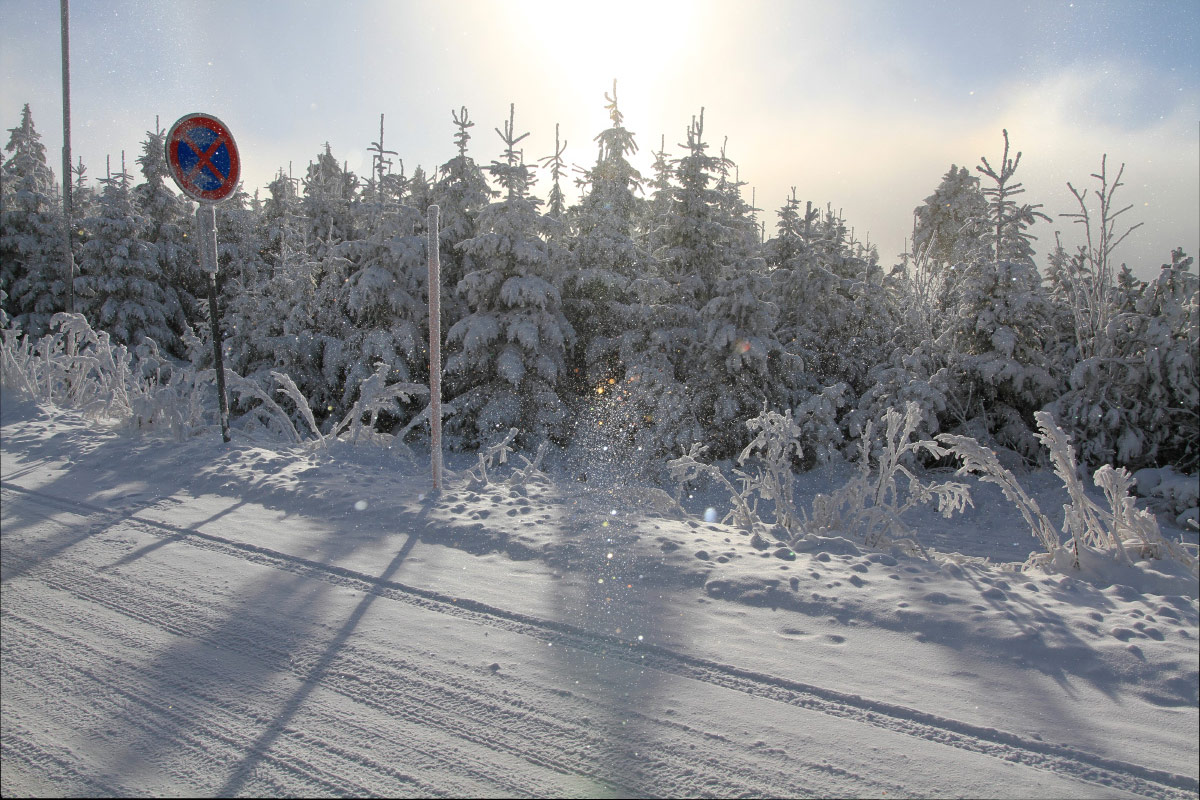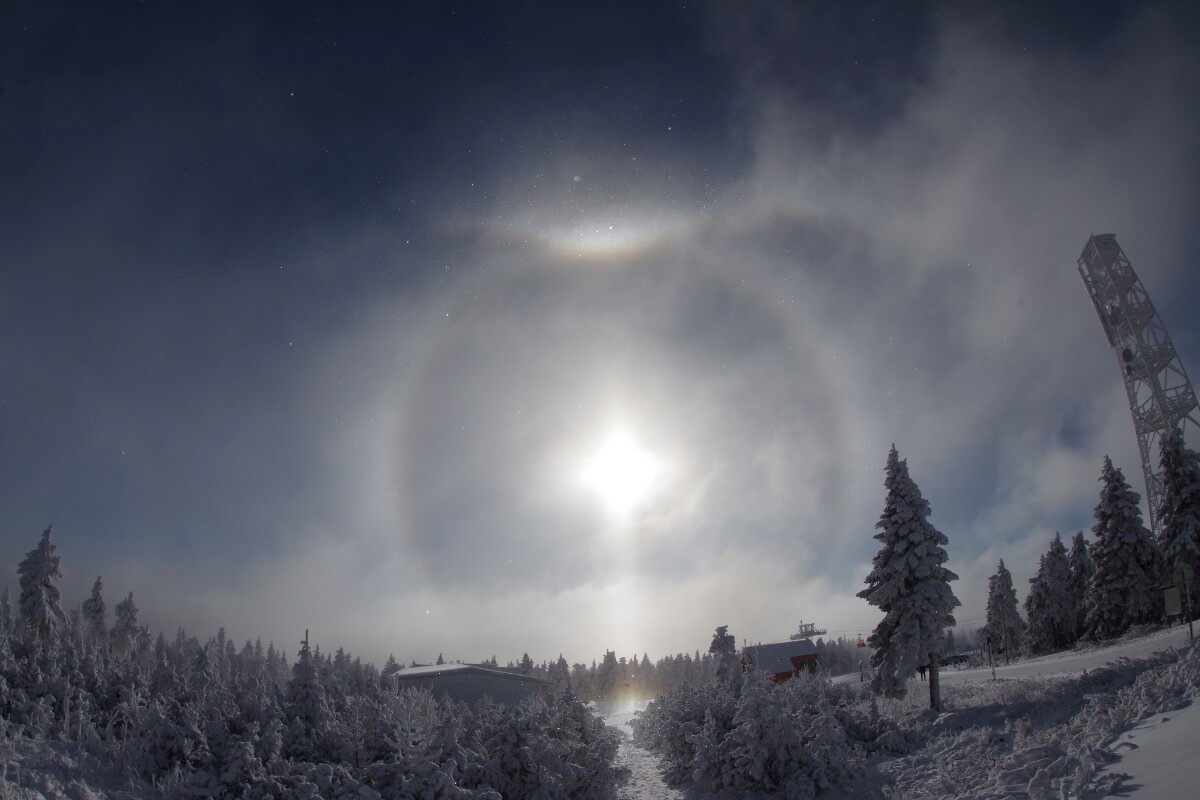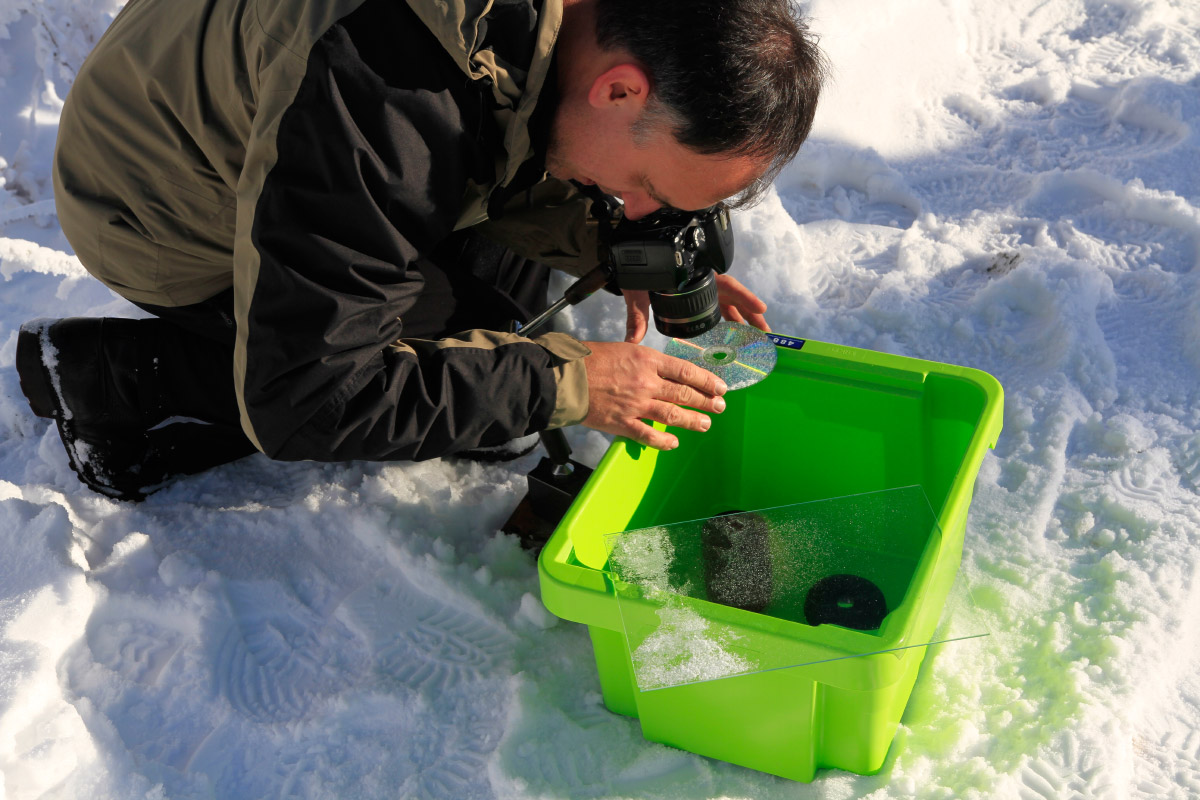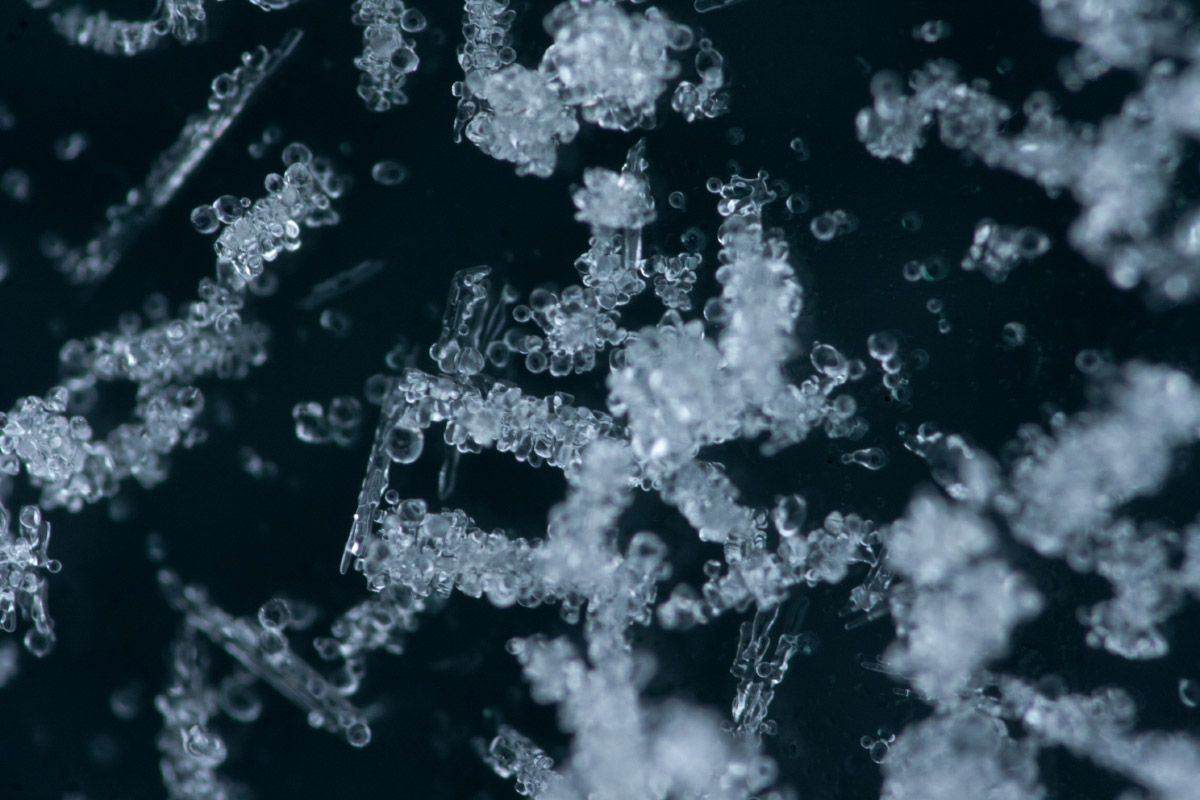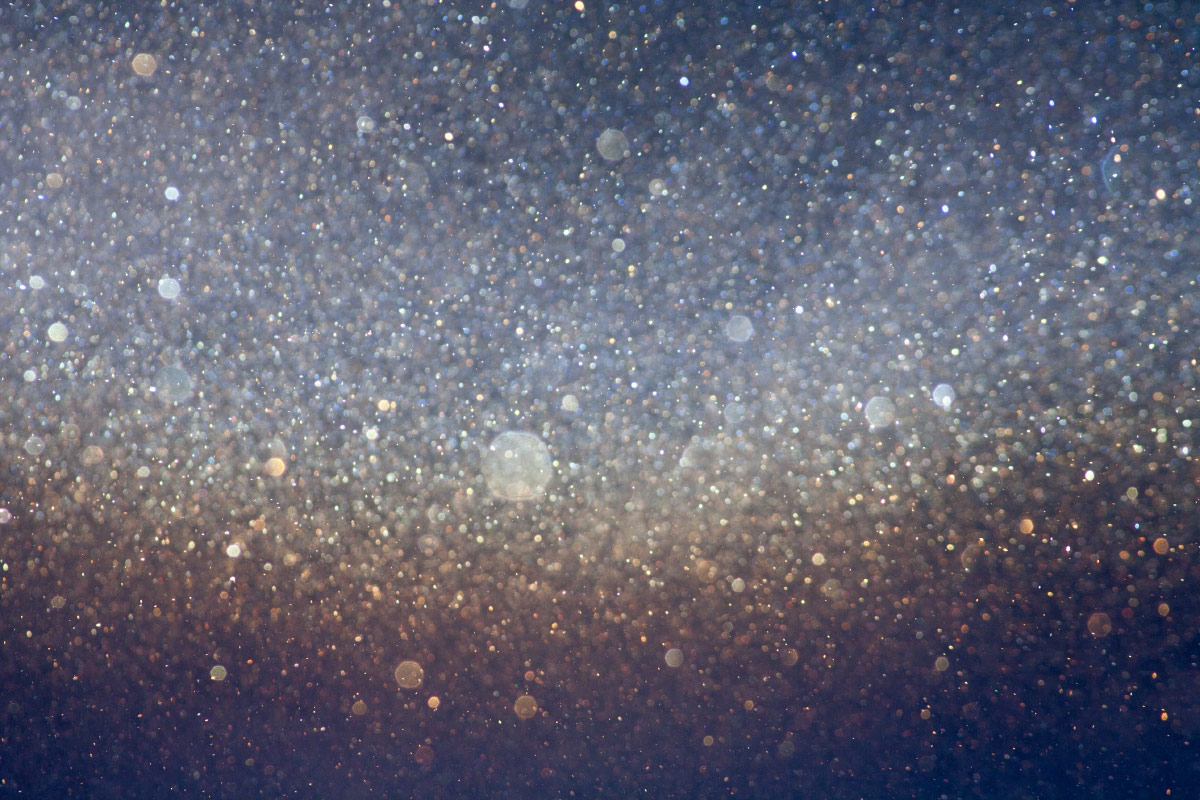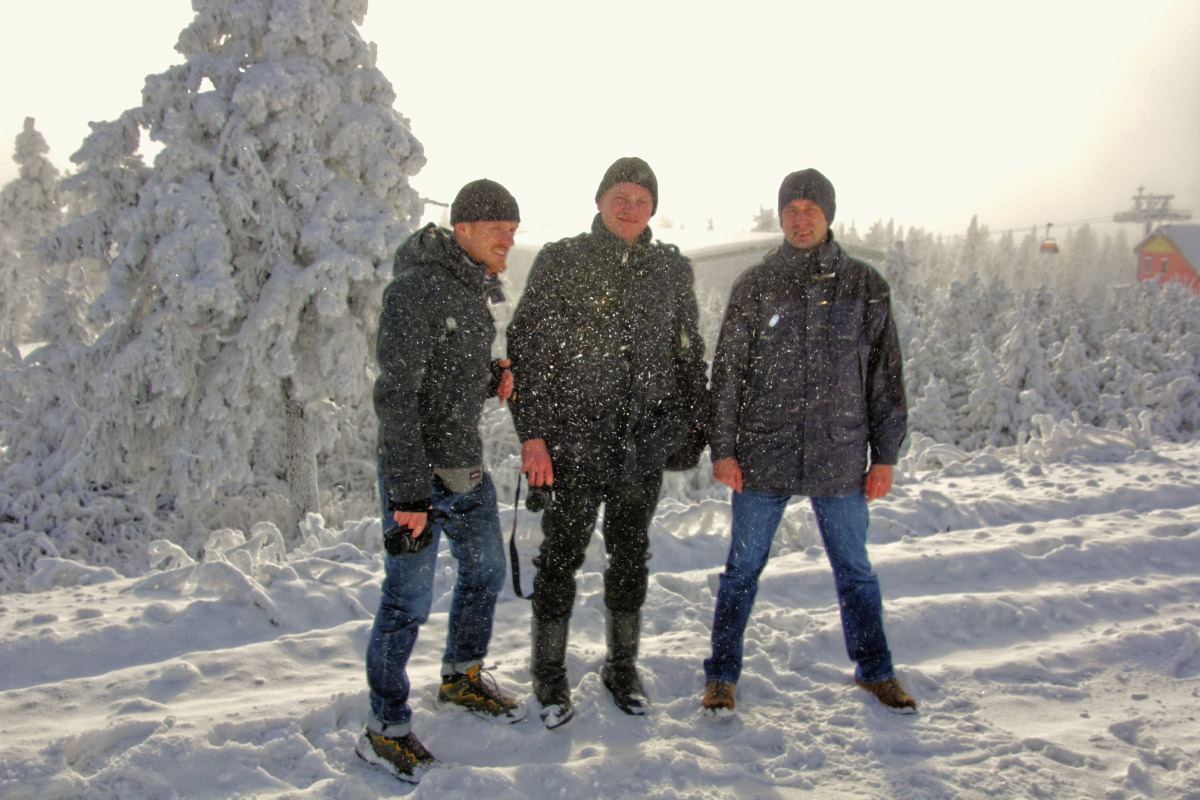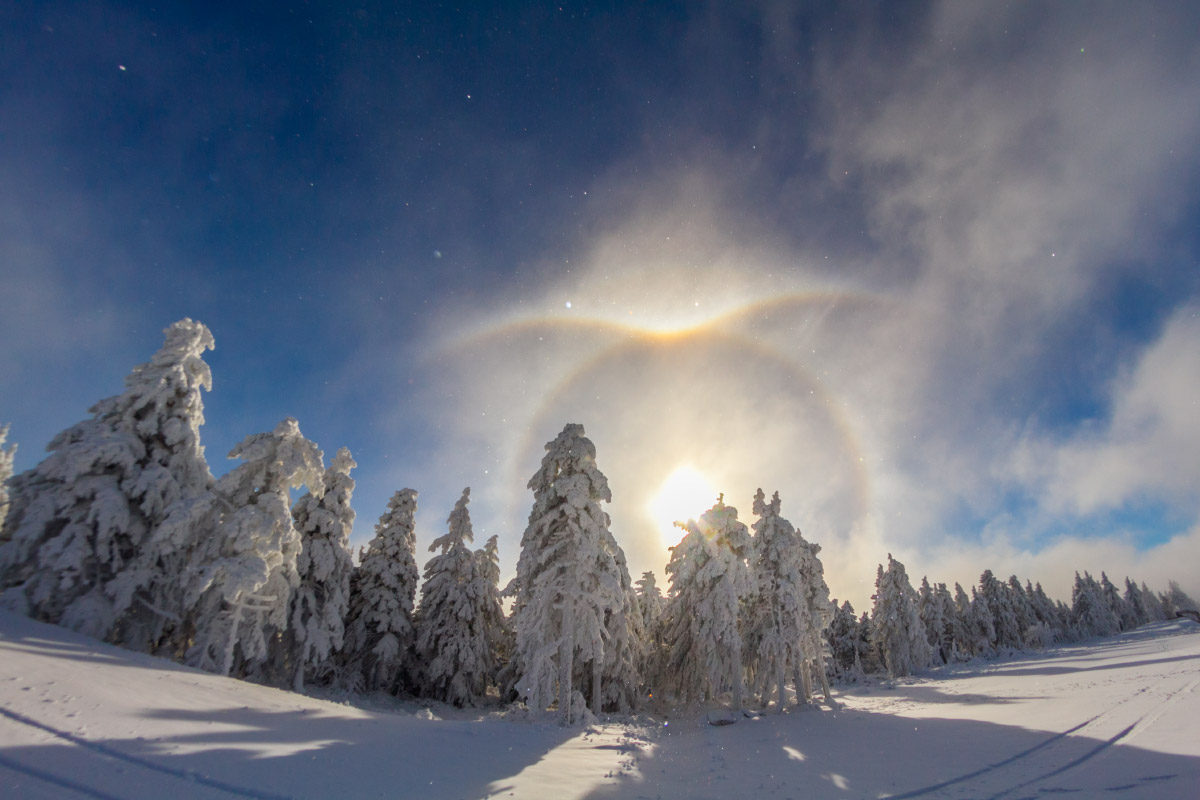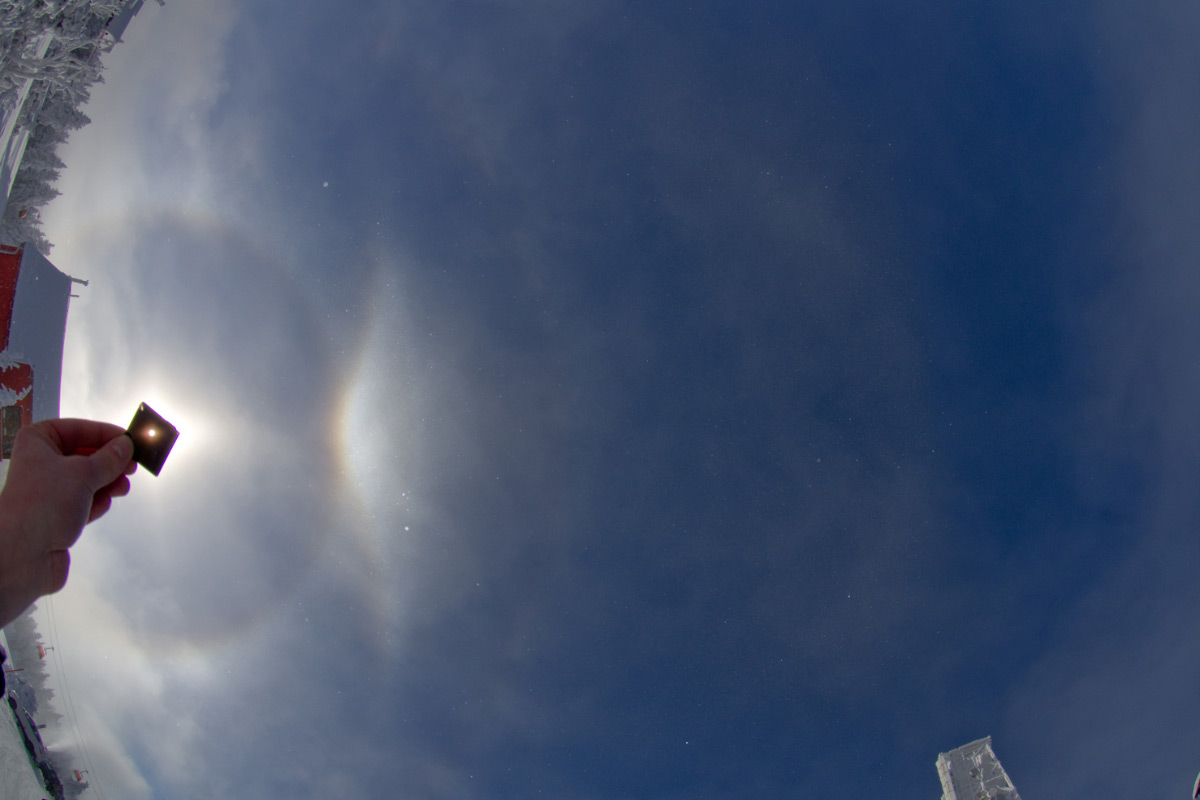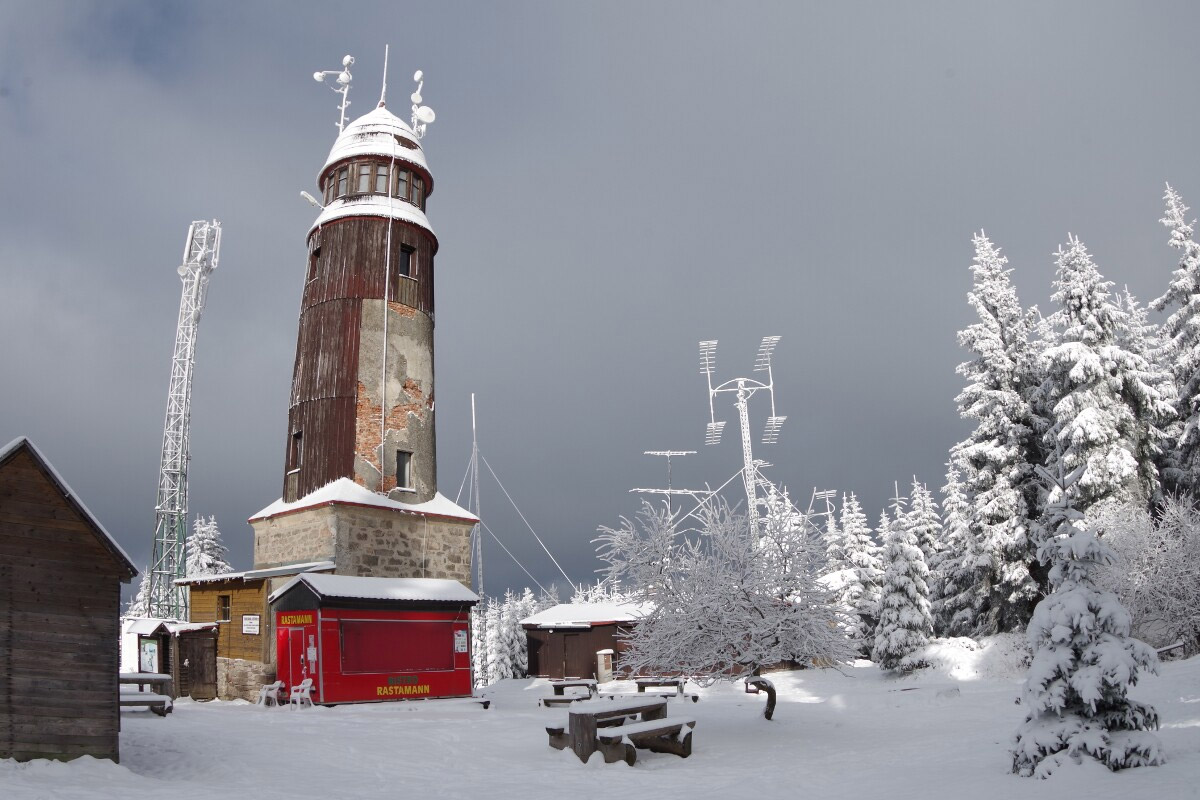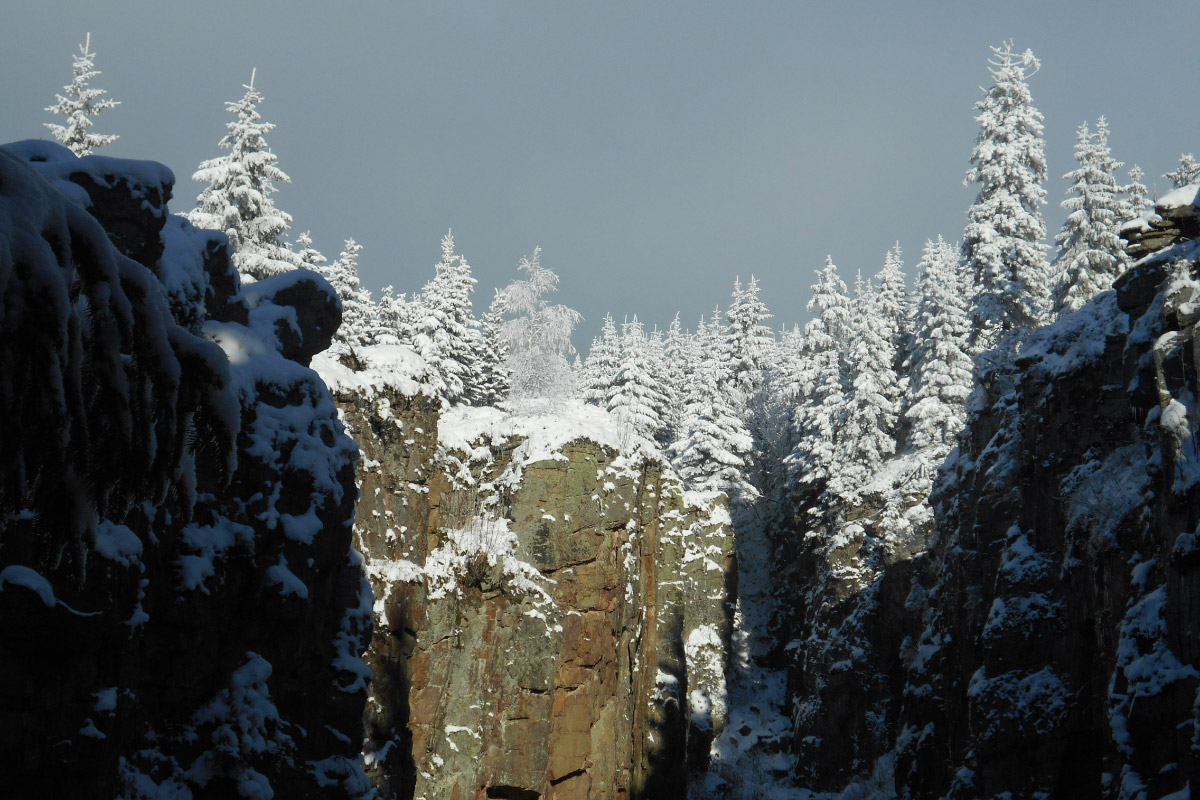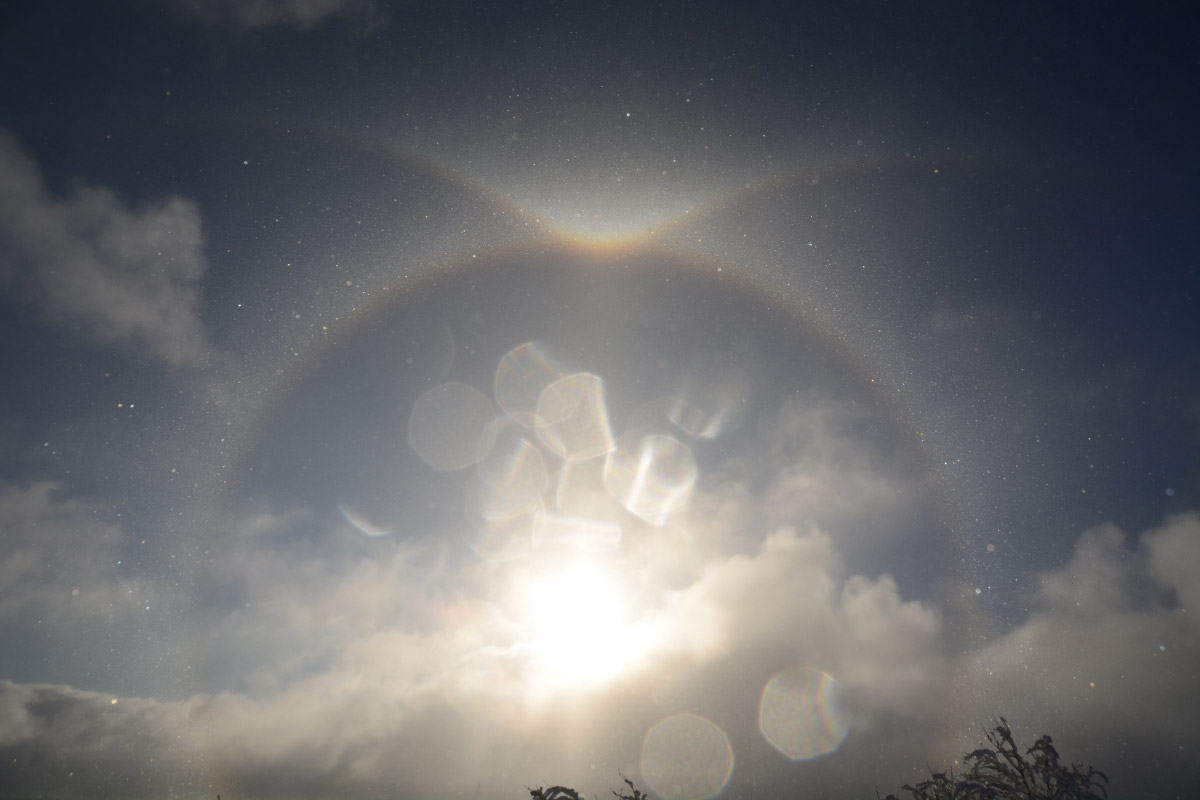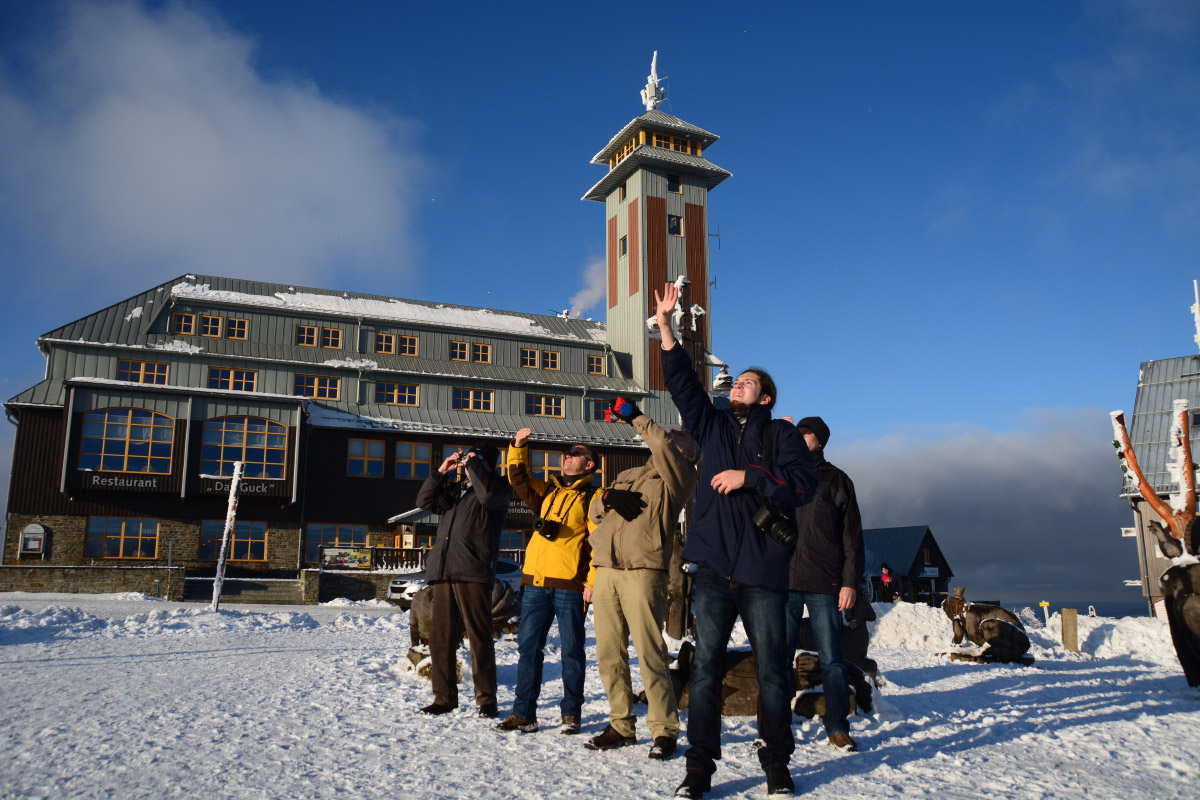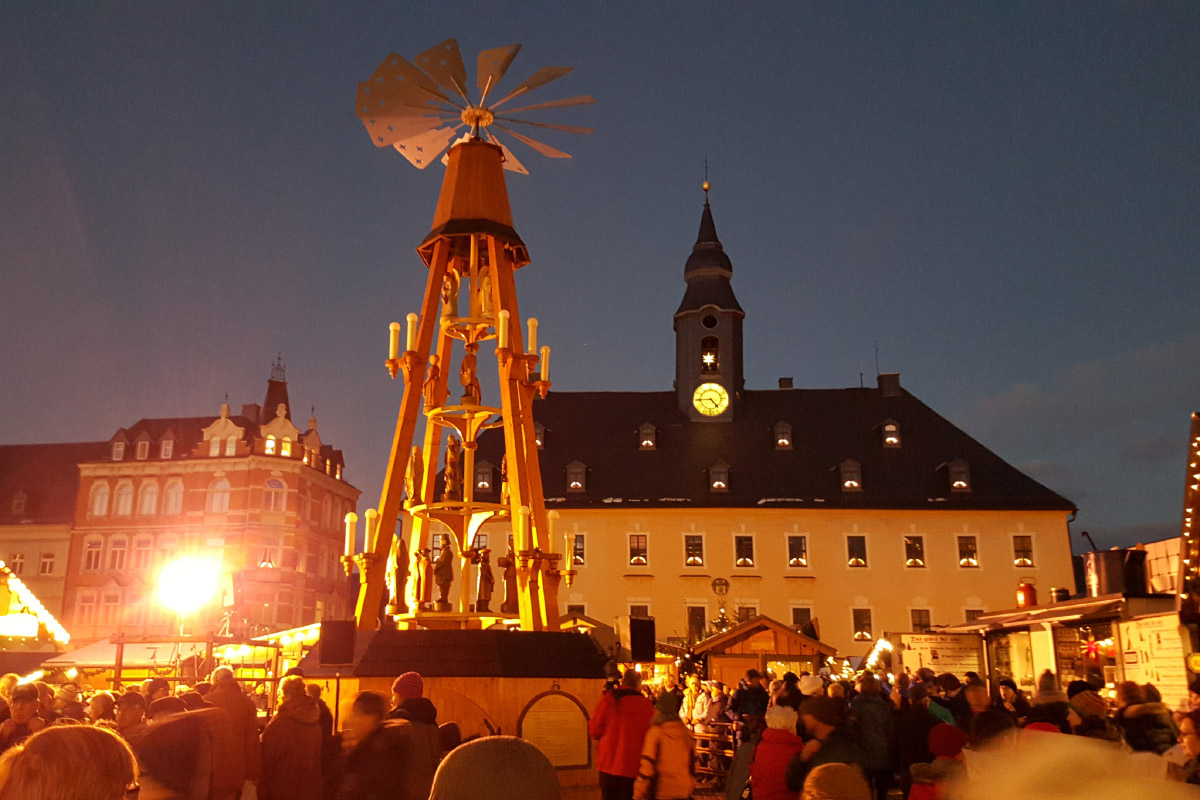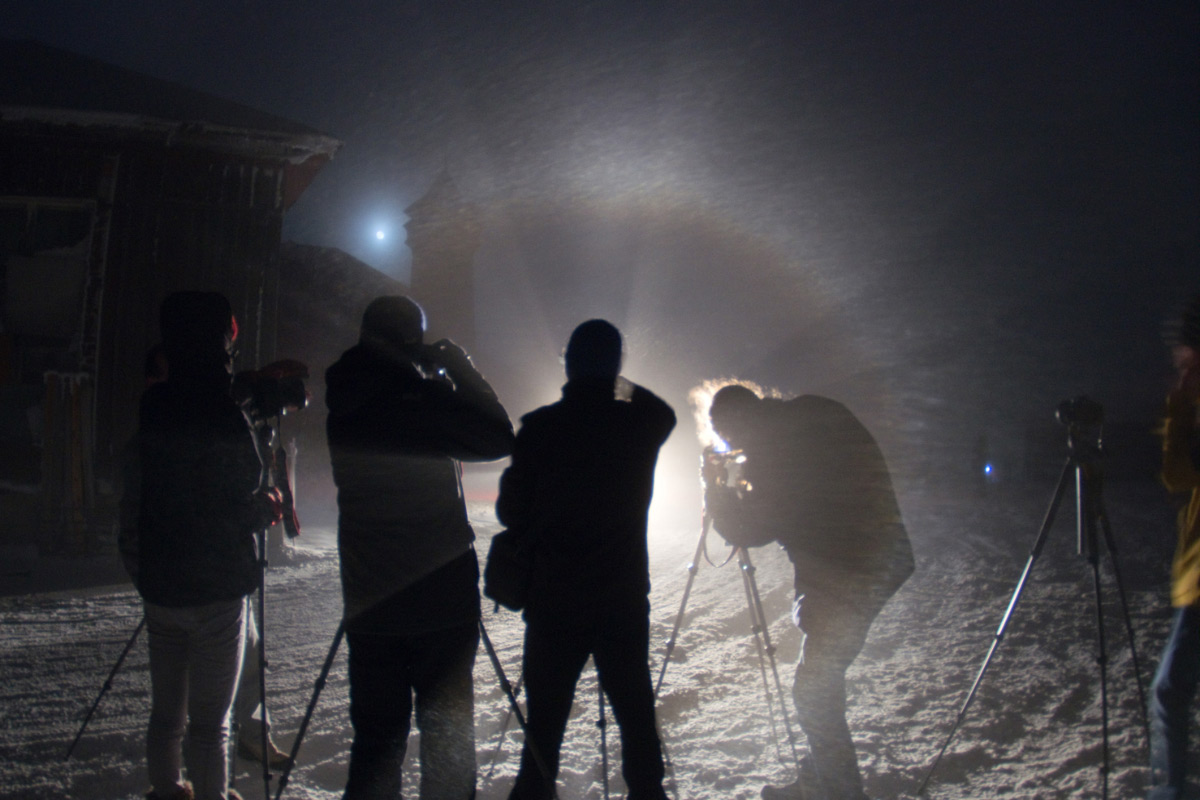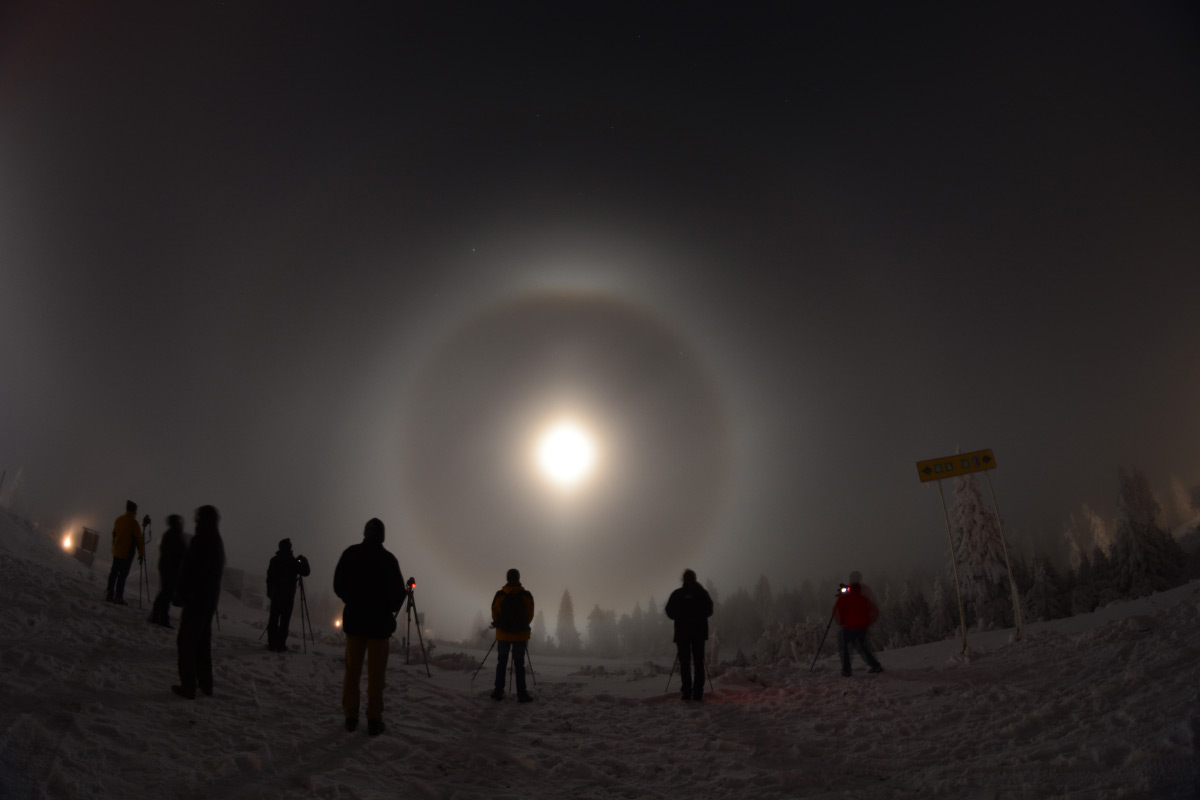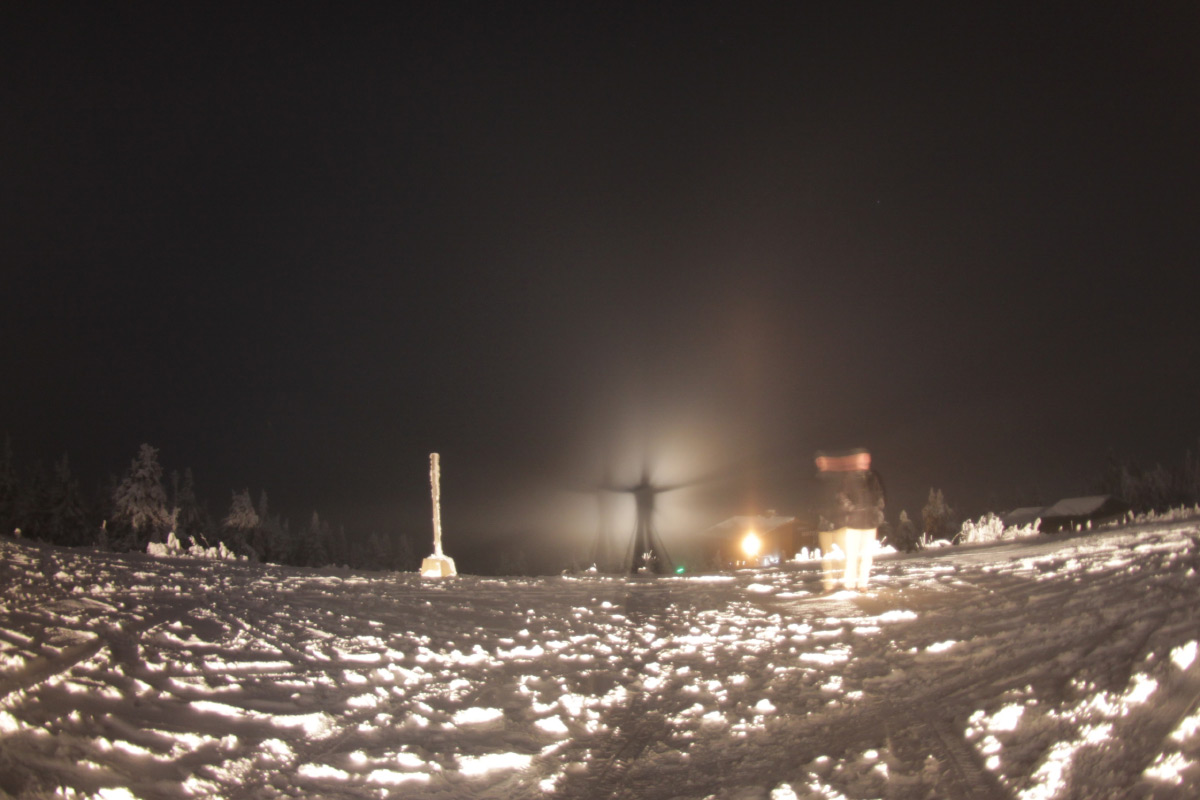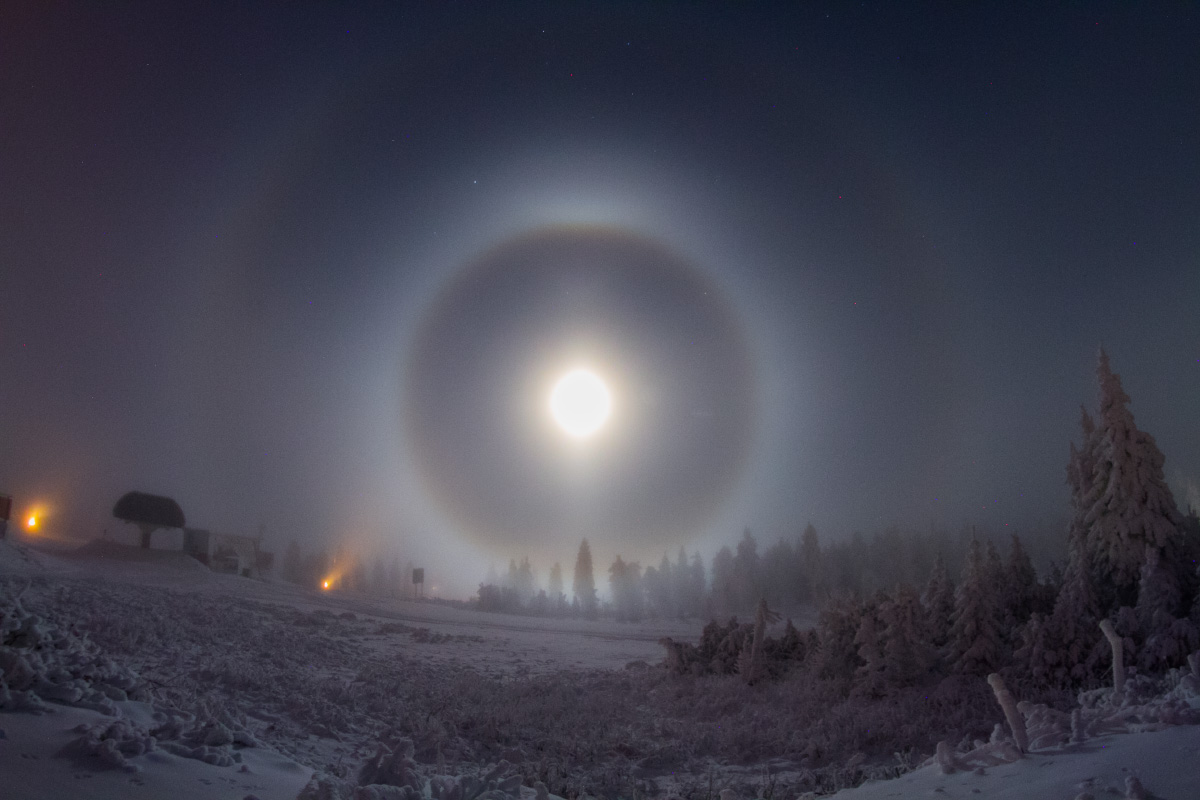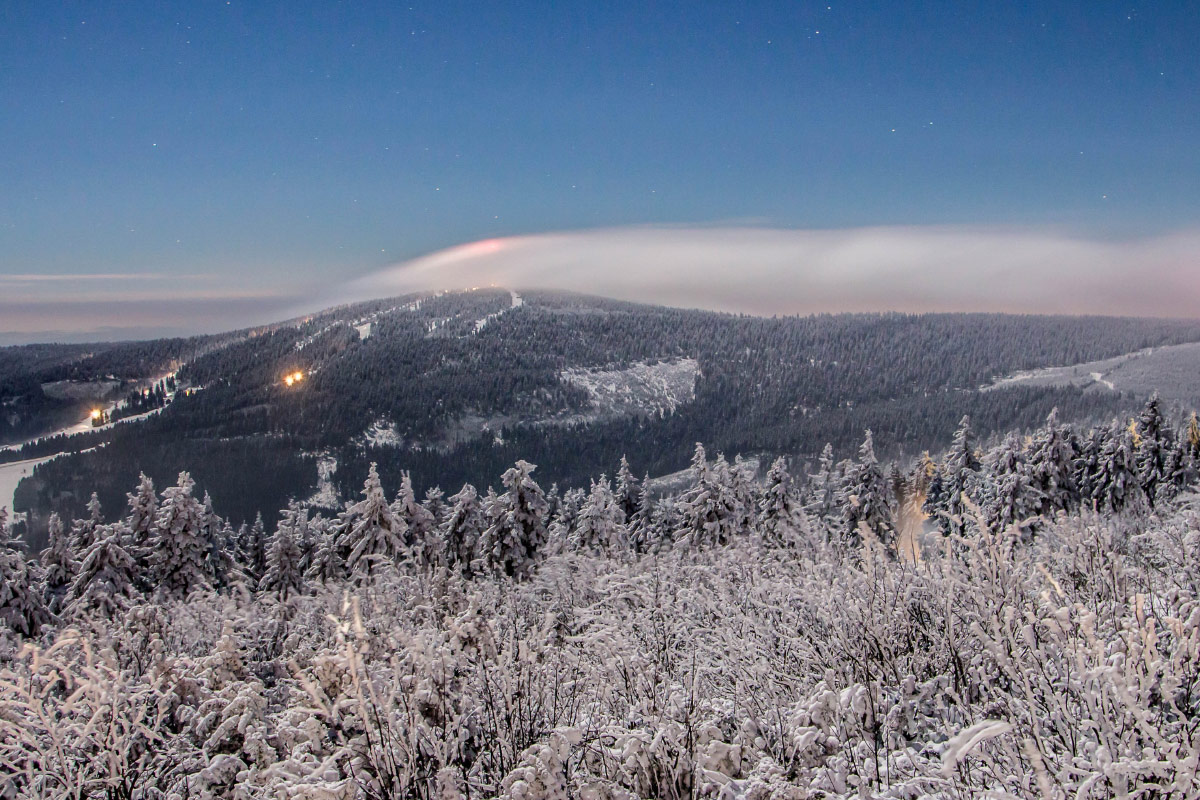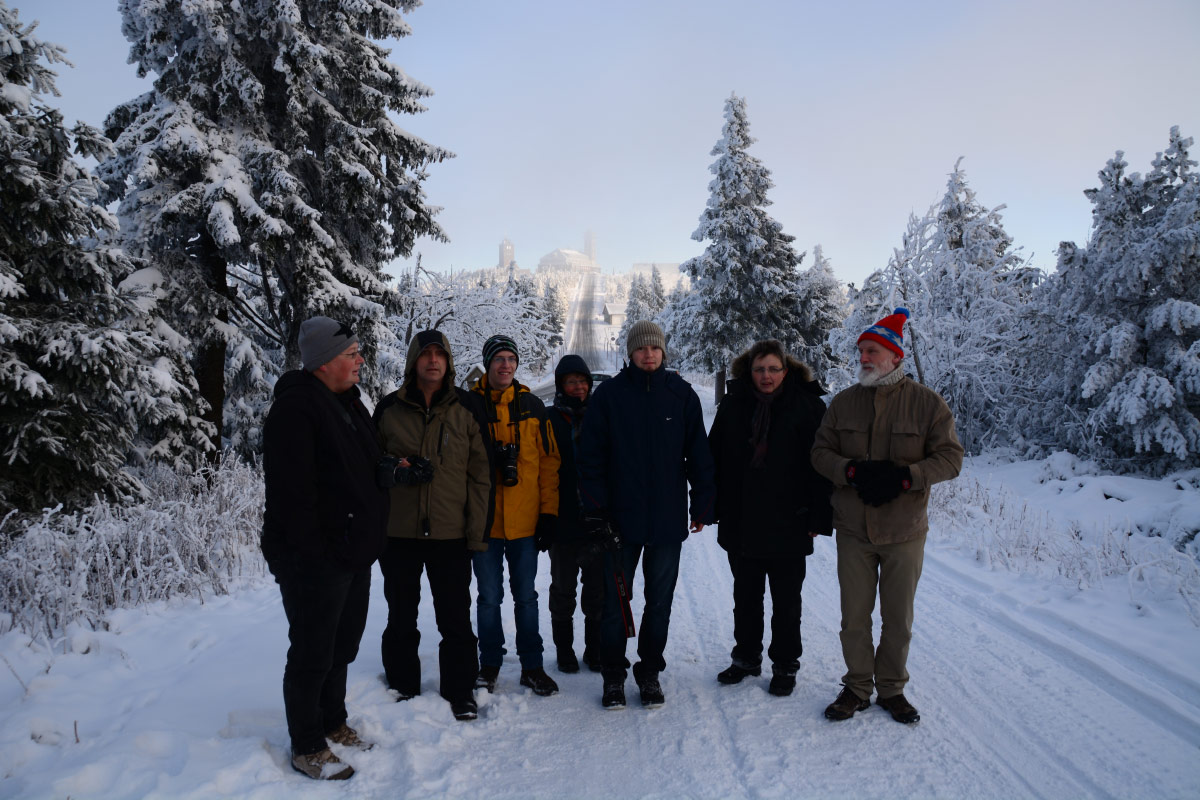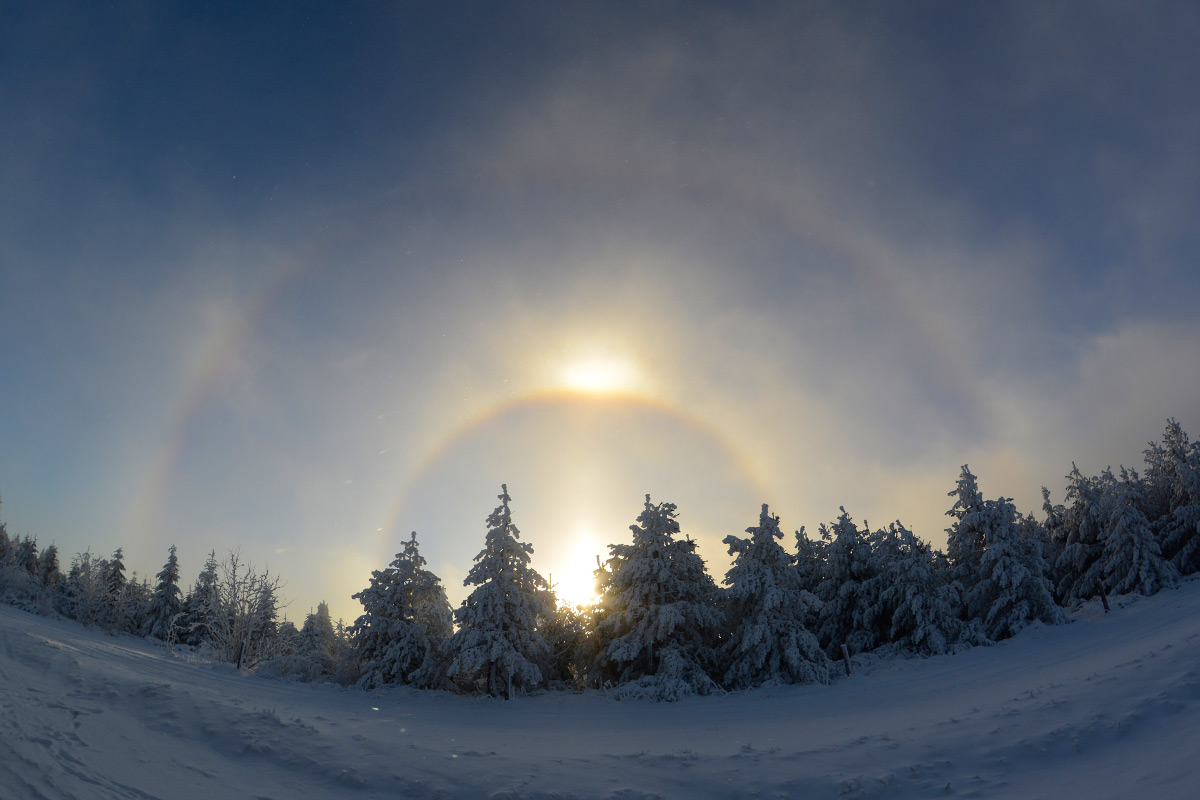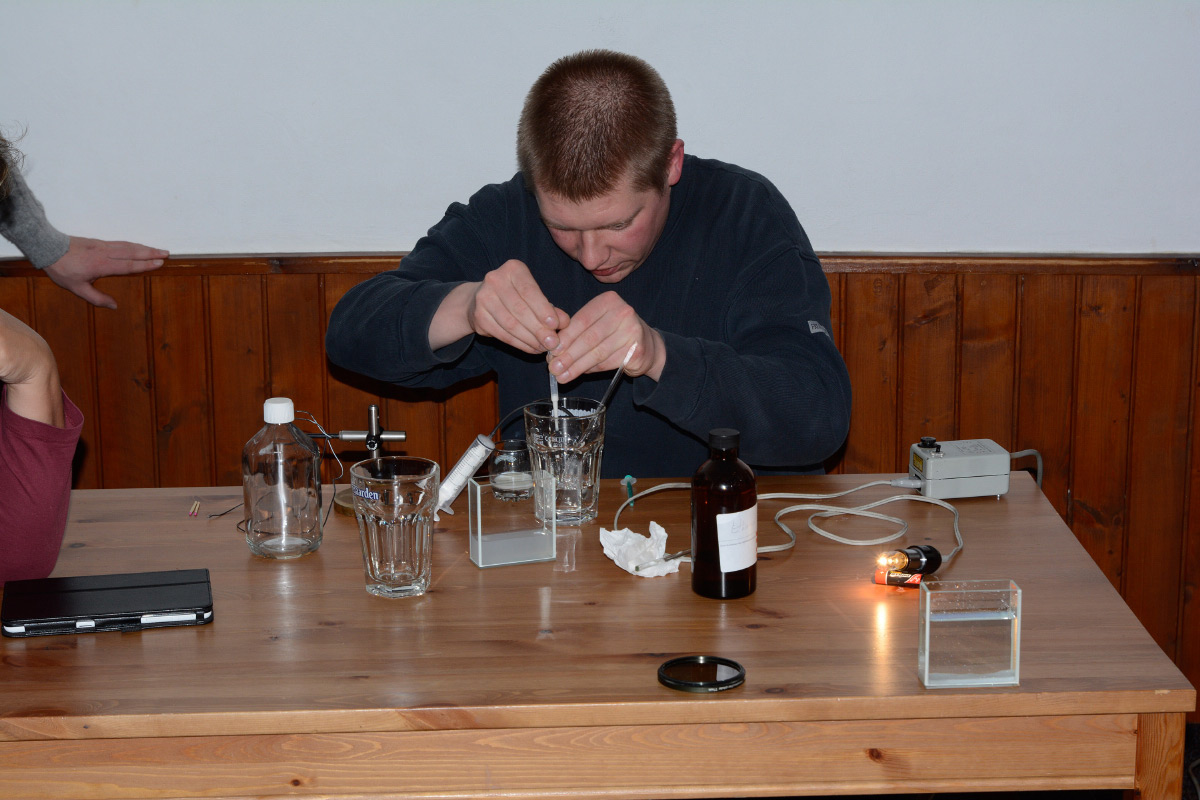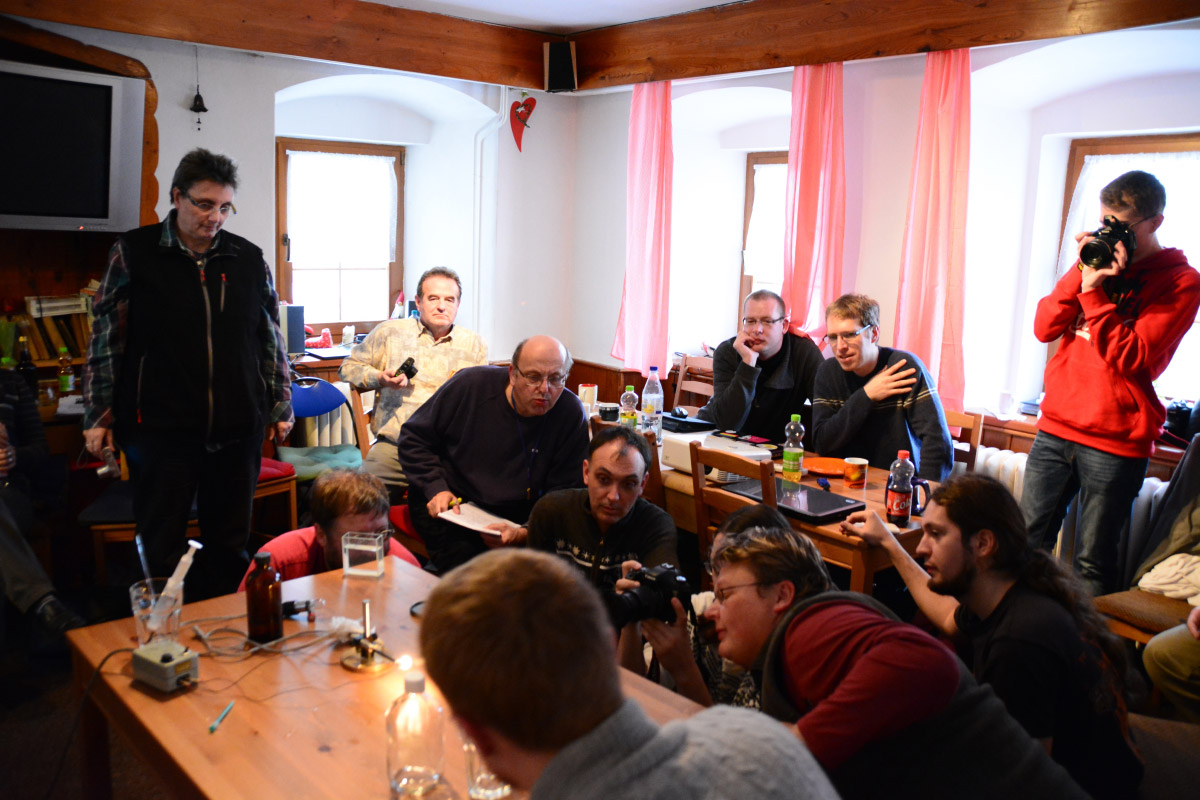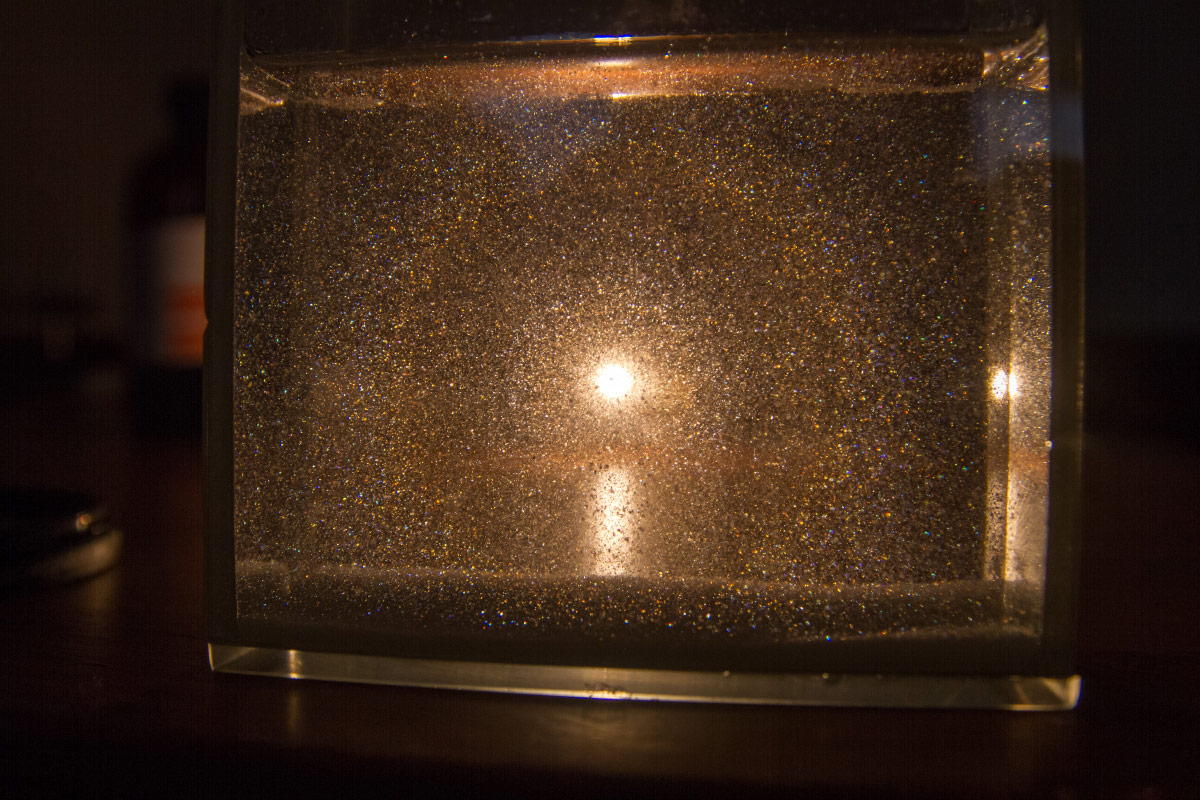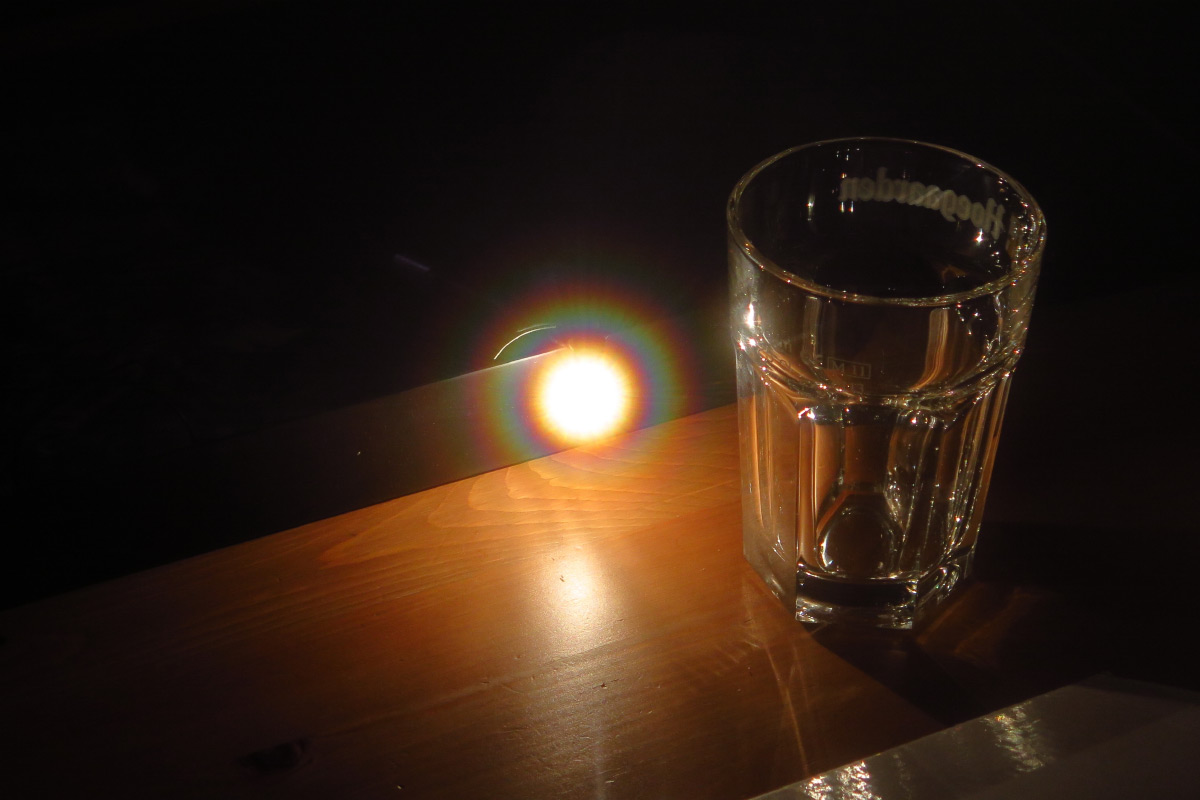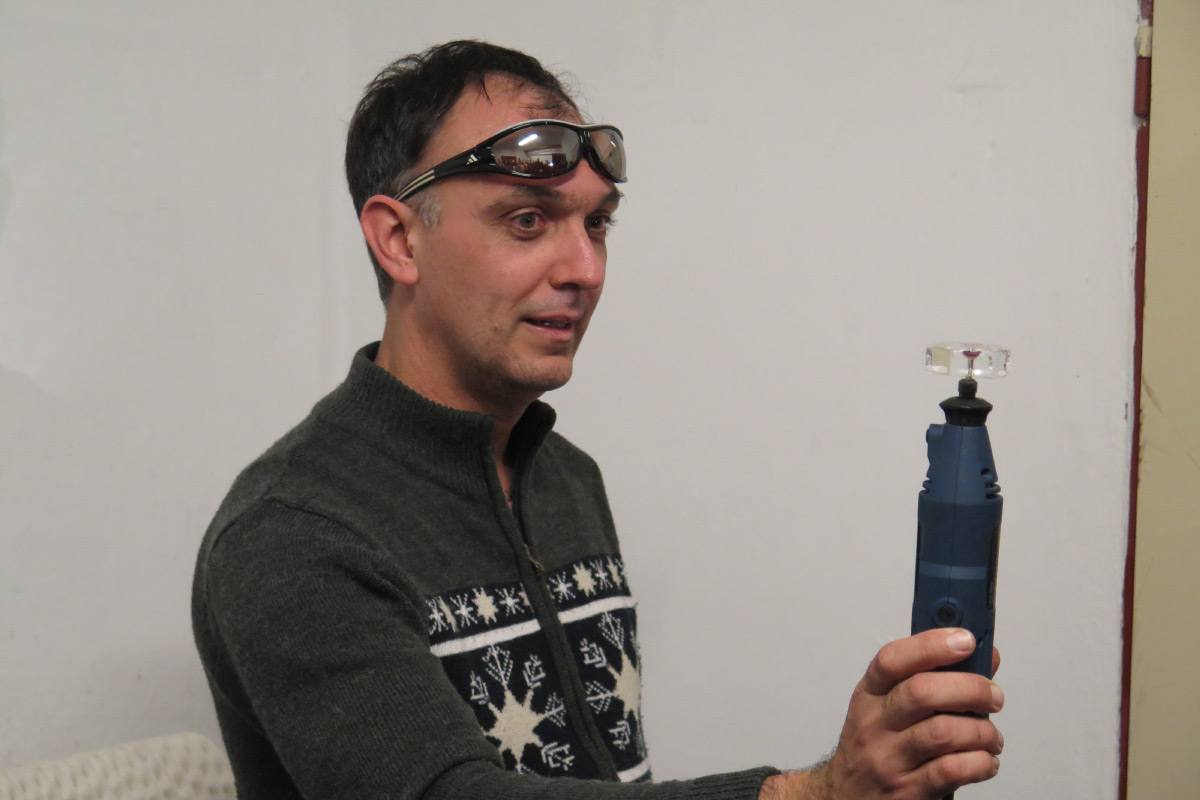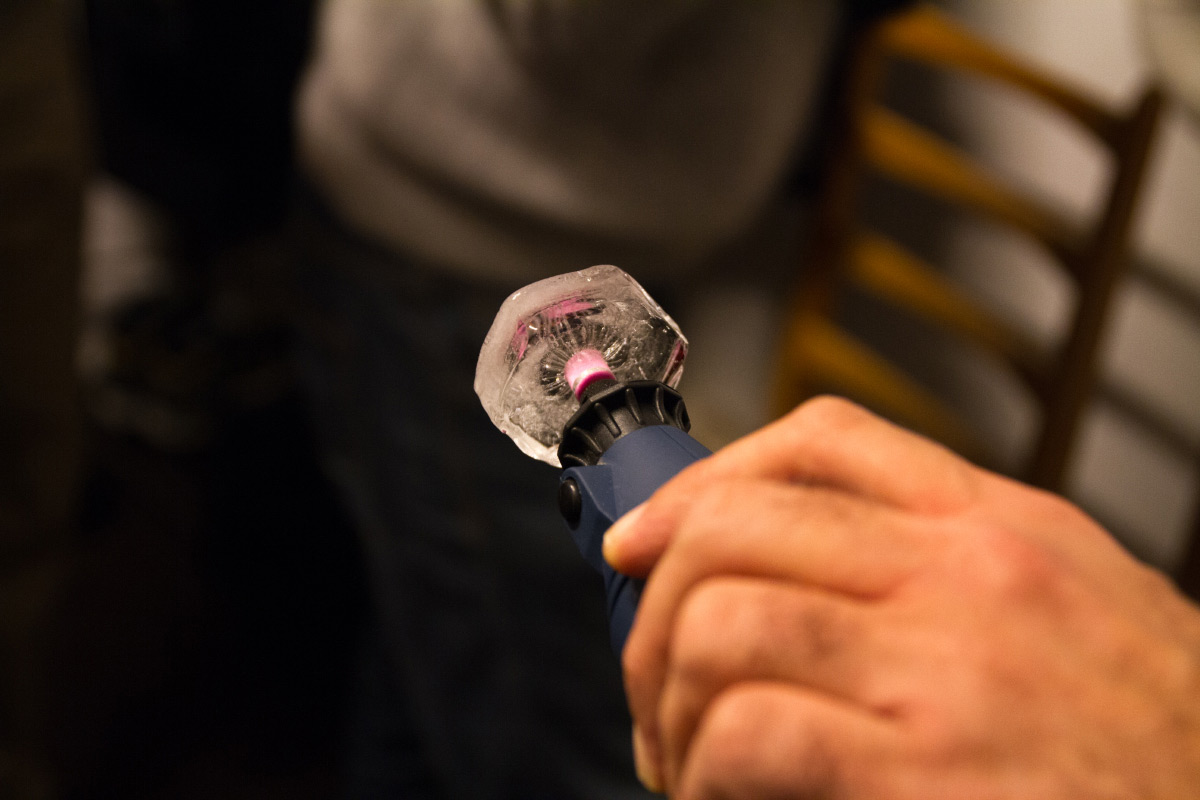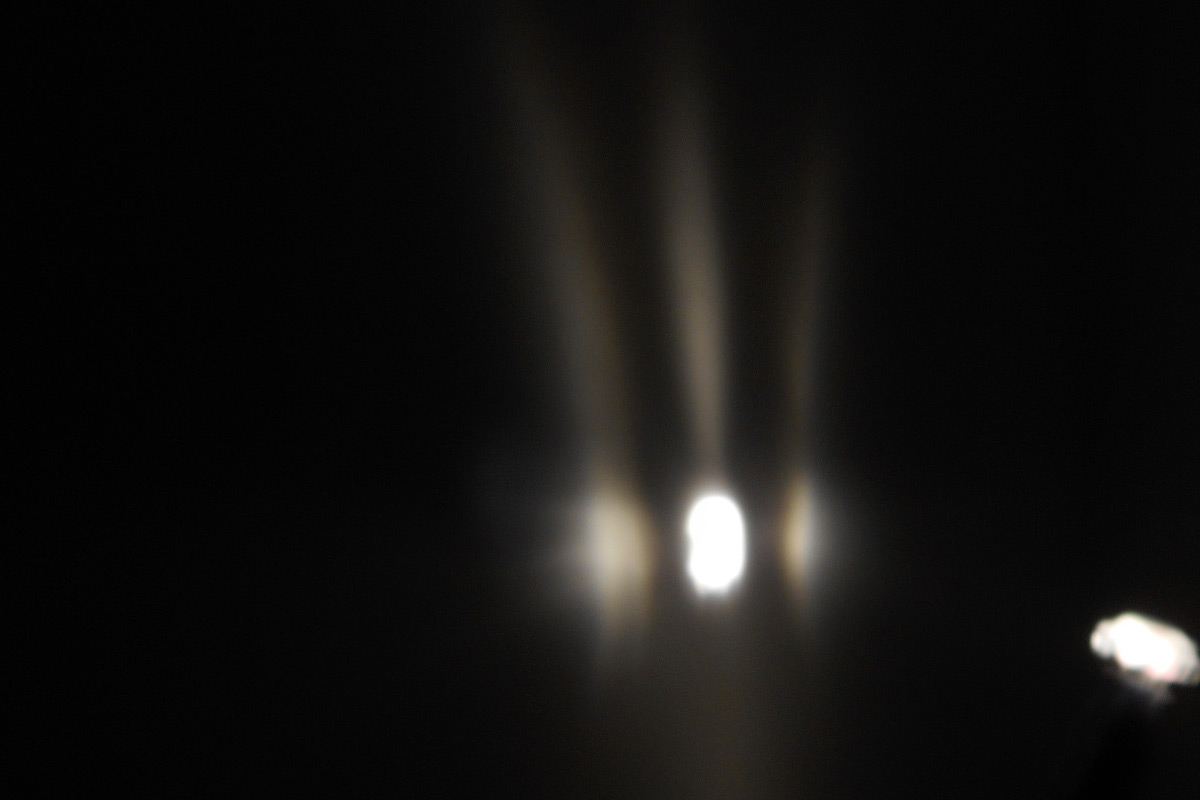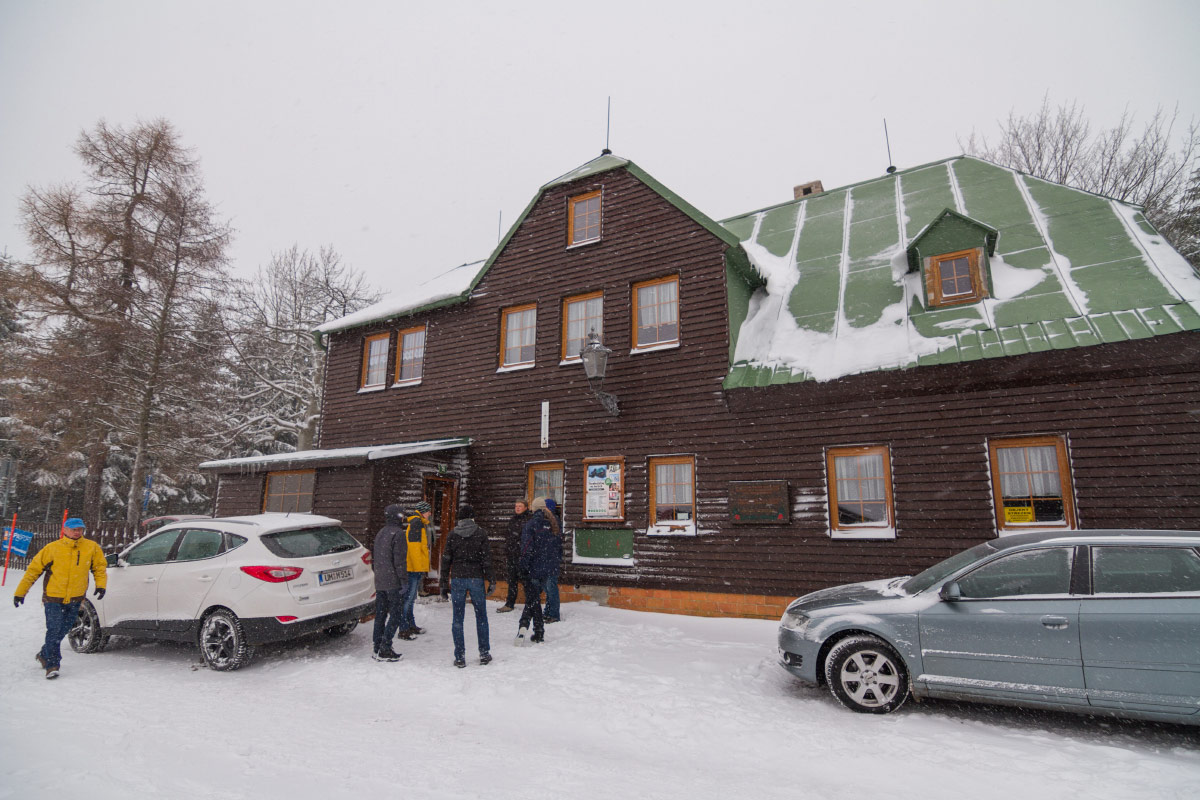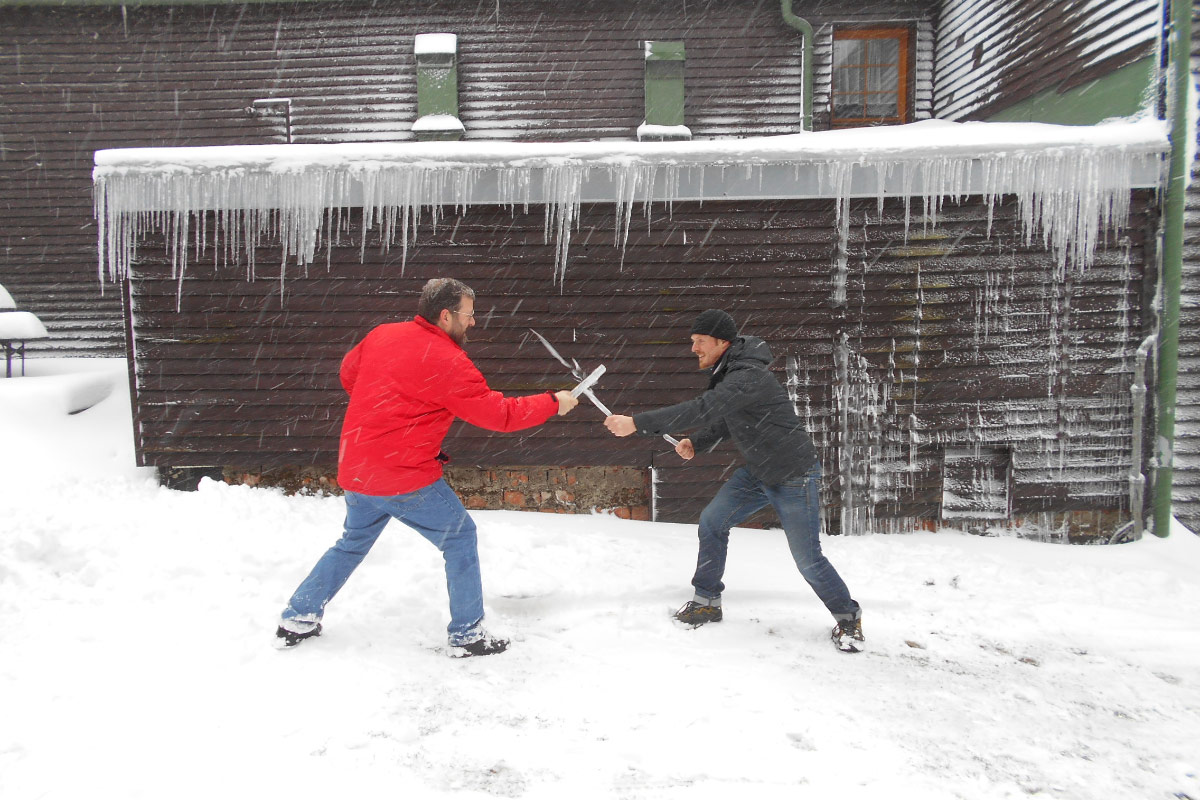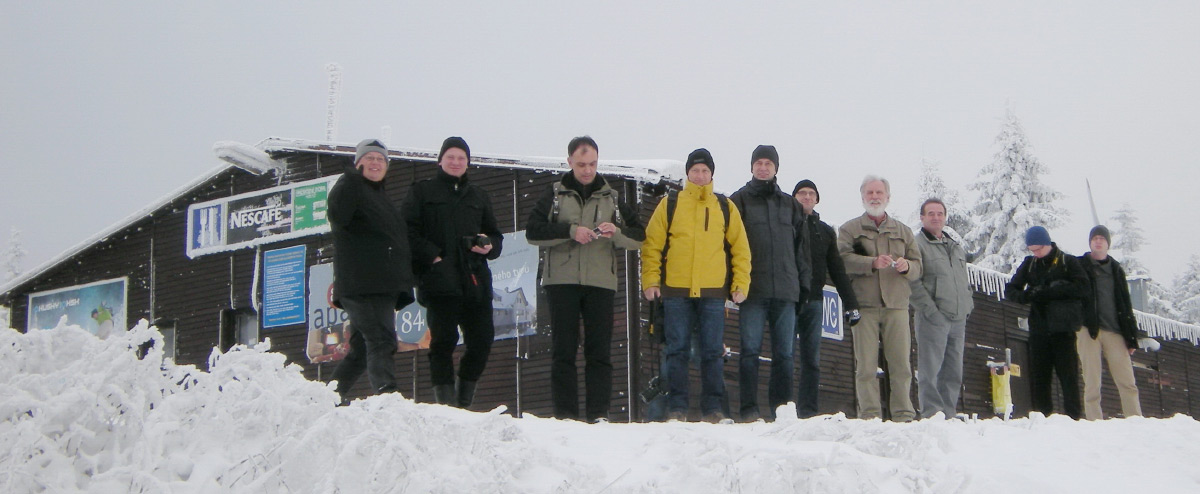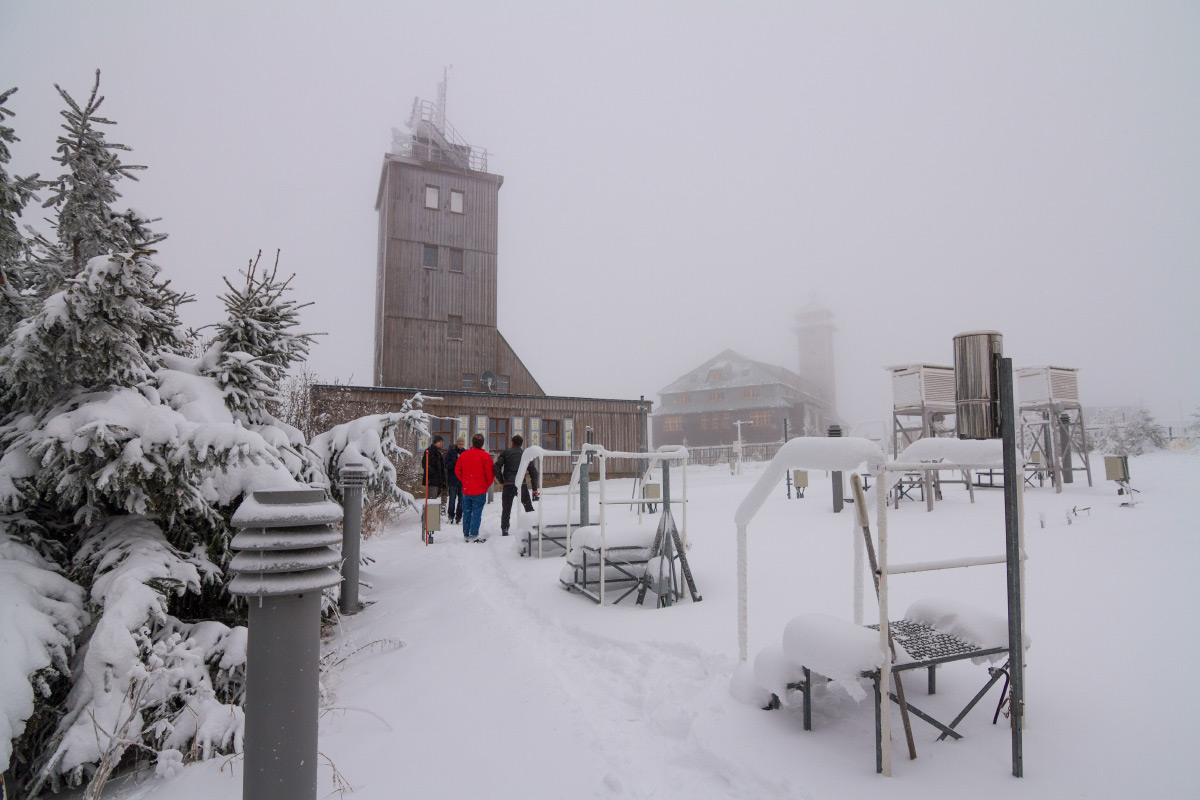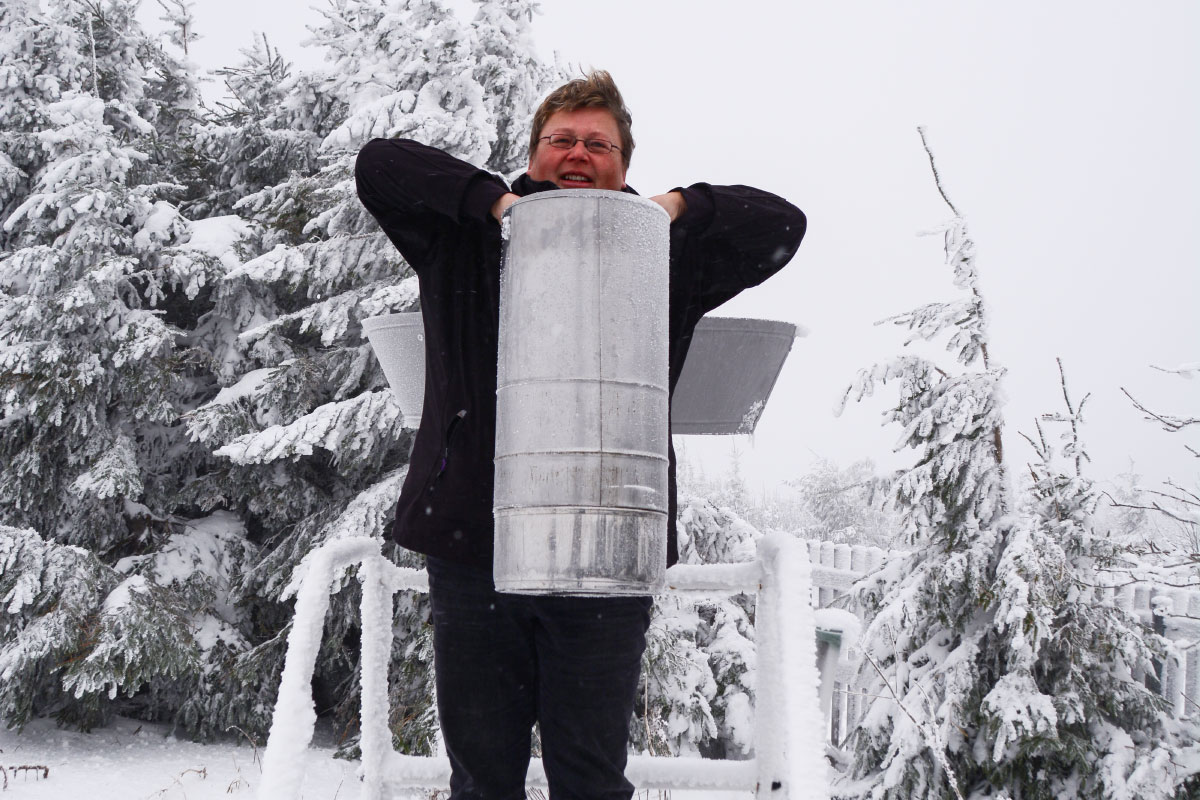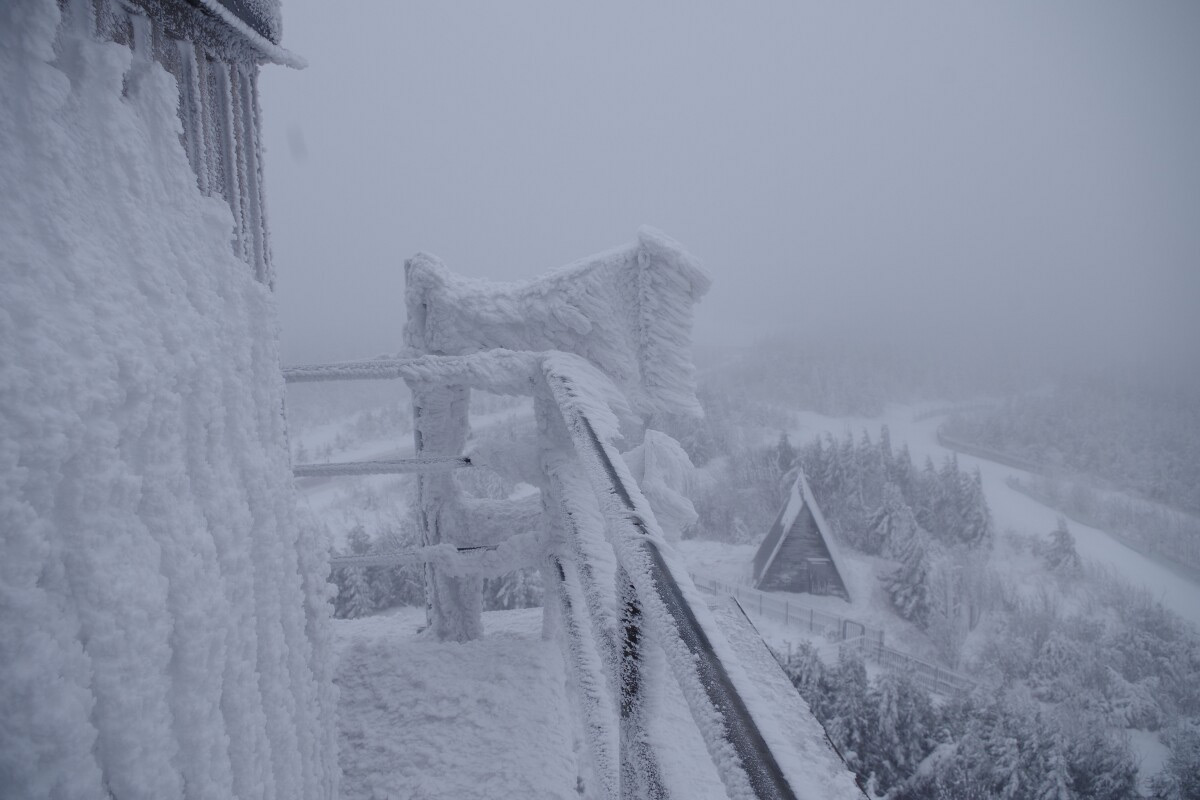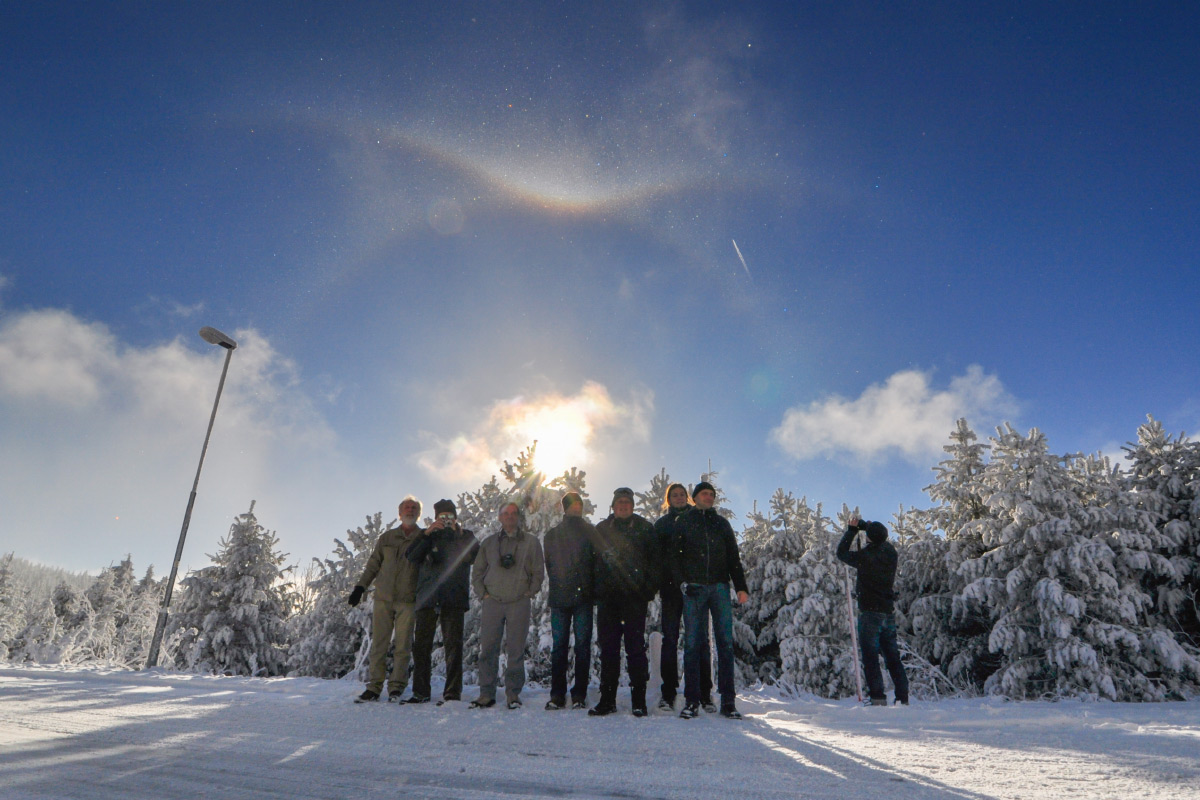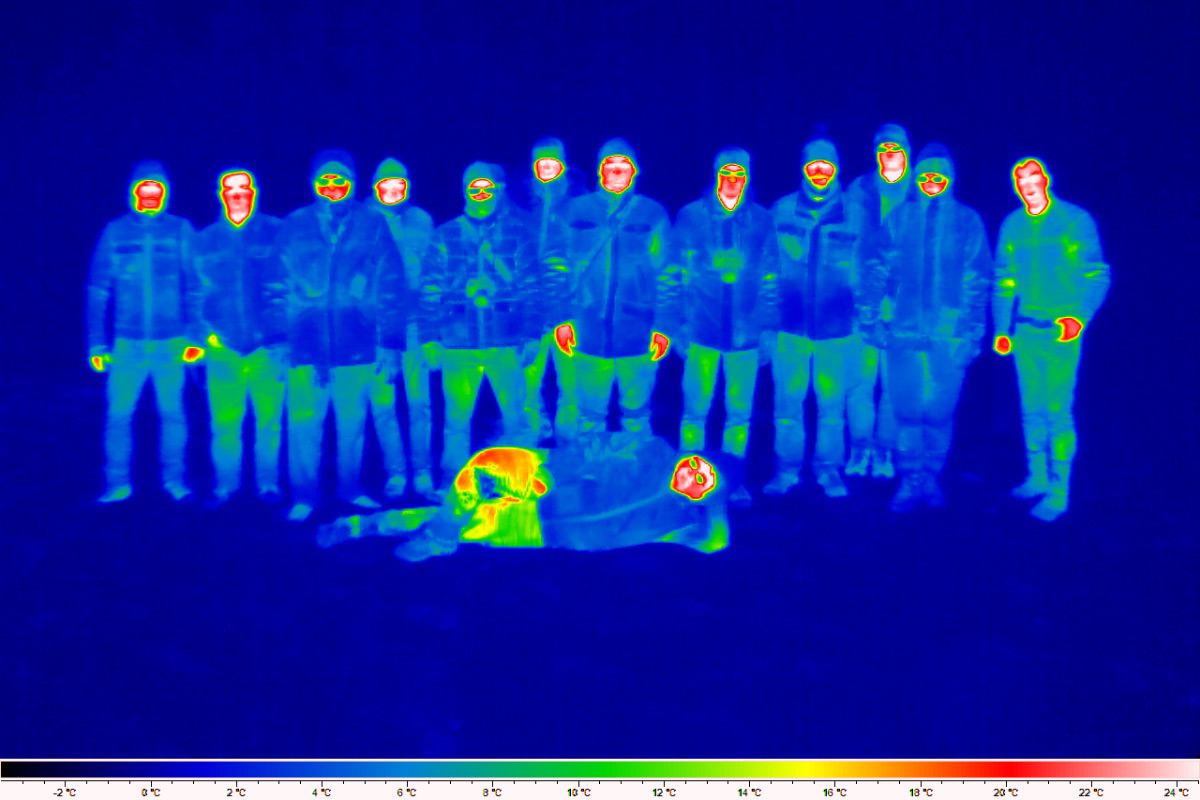- from Thu, 26.11.: our diligent organizers Claudia and Wolfgang Hinz (Schwarzenberg); Kevin Förster (Carlsfeld); Christoph Gerber (Heidelberg), Andreas Möller (Berlin), Elmar Schmidt (Bad Schönborn) Roland Winkler (Potsdam; until Saturday); Günther Busch (Gotha), Reinhard Nitze (Barsinghausen); Andreas Zeiske (Woltersdorf); Eik Beier and Alexander Haußmann (Dresden), Richard Löwenherz (Berlin) - as well as the hut mouse "Jerry" who disappeared without a trace ...
- from Fri, 27.11. Georg Dittié (Siegburg), Thomas Klein (Miesbach), Laura Christine Kranich (Kiel), Michael Theusner (Schiffdorf)
- only Sat, 28.11. Ina Rendtel, Marion Rudolph (Potsdam)
11/26 - Arrival
For the second time, (this time even 19) observers and friends of the AKM gathered behind Fichtelberg in the Czech ski resort Boži Dar, once again in the former residential house of the Ore Mountain folk poet Anton Günther (1876 – 1937), now rented as a ski lodge. The "performers" in order of appearance:
27.11. - Friday
In fact, those present looked rather pessimistically the next morning (27.11. from 9:30) from the Neklid station, shadowed by a cloud, down into the also predominantly cloudy Bohemian Basin. The calm promised little improvement. While some observers on the Fichtelberg (1215 m) enjoyed the sun for about 30 minutes but found no peculiarities in the sky, Kevin Förster directed the cars of Andreas Möller and Claudia Hinz to the road through the forest between Neklid and Keilberg. And that's when it started!
After finally calling the "Fichtelbergers," everyone eventually experienced a fully developing natural ice fog halo phenomenon, all of the non-Erzgebirglers for the first time. Meanwhile, the cloud covering the Keilberg had cleared, and halo-forming ice crystals fell from the cloud fog moving over the ridge from the west.
First, from around 10 a.m. (sun height 14°), everyone noticed the Upper Tangent Arc (UTA), formed by myriads of flickering, flashing crystals, glowing yellow-orange on the sunny side. A slightly weaker 22° halo joined it, and where the sun shone, there was also the narrow Lower Tangent Arc (LTA) tapering downwards. This was best seen against the shadowy forest edge or even in front of nearby people, most clearly when moving slightly from side to side. It demonstrated the three-dimensionality of the phenomena most clearly, which most fascinated the ice fog halo novices and cannot be compared at all with cloud halos, especially as the pattering of the tiny crystals on the snow jackets effectively underscored this experience.
While all the cameras were trying to photograph the halos with continuous shooting, the selflessness of Reinhard Nitze must be highlighted, as he mostly turned away from the phenomena to document the ice crystals microphotographically. And indeed, his shots from Friday morning, matching the existing halos, showed almost only small columns.
Above the OBB, the spindle-shaped bright field forms with increasing crystal density episodically and finally its upper closure, the concave Parry arc, an indication that enough crystals were now doubly oriented.
The observers then drove up to the Keilberg (Klínovec, 1244m), the highest peak of the Ore Mountains, around 11:00, where they stayed until about 12:30. The ice fog was even denser there, ensuring that further phenomena appeared more reliably, which had only briefly surfaced lower down. 22°, OBB, and UBB were constantly in front of everyone's eyes and cameras; first tourists became aware of the phenomenon. Apparently, a portion of plate crystals now also caused weak parhelia and parts of the parhelic circle. However, very clearly and sometimes fully developed, observers now saw the 46° halo or supralateral arc, which are difficult to distinguish from each other at this solar altitude (18°).
Directly above their heads, near the zenith, the sharply defined flash of crystals drifting from the northwest to the sun revealed the contour of the expected circumzenithal arc, although it did not want to properly form as such for the eye. Incidentally, a snow cannon booming and belching out its white cargo did not significantly contribute to the phenomenon, which was therefore solely due to the falling ice fog.
After more than two hours, habituation effects set in, and it was fortunate that the ice fog became so dense that the halos receded. Following a suggestion from Claudia and Wolfgang, our convoy of cars drove through a wonderfully lonely winter landscape along the wild natural Czech side of the Ore Mountains to Plattenberg (1044m), where we planned to refresh ourselves at the popular snack bar known as Rastaman's, which was unexpectedly closed. So we went straight down 100 meters rather steeply through a spruce forest to the ice and wolf sinkhole, a collapsed old mining tunnel system. Persistent ones who climbed down into the old pits were pelted with snowballs from above. The calm and bright sun from a piercingly blue sky on a clearing on the mountainside made it rather enjoyable.
To have lunch, the Fichtelberg was approached again. But by 2:00 p.m., those orienting themselves outside noticed that ice fog halos had appeared there as well, which, according to Claudia, is comparatively rarer than in Neklid and on the Keilberg. But today theory did not matter, so the gathered team spent another hour and a half enjoying watching and photographing in the warming afternoon sun.
The nice thing was that, unlike on the Keilberg, the Fichtelberg halos unfolded against an almost homogeneous blue sky and were produced by ice crystal clouds at all levels, from within reach to perhaps 100m away. Thus, the OBB, sometimes extending in huge horns, pulsated partly in the rhythm of just a few seconds from different distances. The 22-degree halo was also sometimes within reach and stood out as a glittering crystal swarm in front of the shadow sides of the mountain plateau's structures. Yes, even more, the freshly fallen crystals made the 22-degree halo stand out well as a snow cover halo on the already trampled old snow. And around 3:30 p.m., a very bright pillar formed around the sun, about whose distance nothing could be said since hardly any individual crystals were visible flashing here.
After these spectacular two halo performances, the day’s participants drove to Annaberg to meet the latecomers. Beforehand, we looked at the "butter barrels" (basalt columns) on the Pöhlberg slope in the late daylight to then oversee the sunset across; which indeed winked a green flash from a gap in the clouds, which however remained as unexpected as it was photographically undocumented.
The traditional Erzgebirge Christmas market of Annaberg, with a music-accompanied Christmas pyramid "pushed" by the miners' orchestra and children reading descriptions of their carved figures, was another but not the last highlight of the day. While Georg Dittié waited 25 km away in front of the deserted Chata and had to be rescued by Claudia, the "heroes of the day" still got acquainted with Thomas, Laura, and Michael in Annaberg over hot drinks, fat sandwiches, and other strengthening dishes, all of whom honored an AKM meeting for the first time.
28.11. - Saturday
Claudia, who provided us with fresh breakfast rolls daily with Wolfgang, already feared on Saturdays that this meeting might continue without a lecture program; because in fact, Andreas M., Alex, Eik, Kevin, and Laura had also photographed ice halos (22°, OBB, 46°) before 9:00, this time again on the Fichtelberg. However, the fog banks had become much more rugged, the wind had picked up, and the westerly snow and rain front predicted in the weather report was approaching.
The snowstorm, which was also settling around the hut, thus ended the outdoor part of this meeting around 10:00. This allowed a comprehensive program of lectures and presentations to begin again.
The beginning was made by Elmar Schmidt with a summary of the nearly 30 circumhorizontal arcs documented in the AKM Forum of the past summer. Alexander Haußmann addressed this topic from a theoretical perspective and presented extensive Monte Carlo simulations of this halo for cirrus clouds over the real curved Earth, which firstly confirm that the CHA occurs for solar altitudes below the local limit angle of 58° (as also evidenced by photographs), but also show that deviations from its horizon parallelism should occur at larger azimuths. Furthermore, by adding triangular crystals and multiple reflections, he also obtained the theoretical possibility that there could be a "core arc" in continuation of the sun-facing actual CHA.
Subsequently, Wolfgang Hinz presented the proofs of the book "Light Phenomena – Color Plays in the Sky", which he co-authored with Claudia. Claudia Hinz convinced with her lecture on Brocken Spectre, Glories and fog bows, in which she concluded from years of observations from the Wendelstein and the Zugspitze that these phenomena become more frequent and impressive with increasing altitude. She also illustrated her own discovery in the area, the so-called glorifying, which manifests in an asymmetrical transformation of the otherwise circular glory along cloud structures, analogous to the relationship between coronas and iridescence in the sun-facing part of the sky.
Michael Theusner, the discoverer of the natural 4th-order rainbow, first presented interesting techniques for image processing of halos through practical examples. He fundamentally photographs RAWs, from which 16-bit TIFFs are created. The red-blue subtraction on individual images made known by N. Lefaudeux is easily achievable in Photoshop and is useful for spectral color halos, even though the color impressions of USM images are lost in the process. In the presence of image series, stacking is of course an advantage, as demonstrated with a lunar pyramidal halo.
In the second part of his lecture, Michael discussed his window-mounted spectrographic aurora warning system built from simple materials and a no longer needed DSLR, which is triggered by the strongest emission lines. For photographing auroras, he recommended HOYA didymium filters because they allow aurora emission lines to pass through but suppress lines from sodium vapor lamps.
Georg Dittié demonstrated the creation of spherical and 360-degree panoramas using the software PTGui with current fisheye photos from Fichtelberg. Important prerequisites for success are maintaining the nodal point and an overlap of about 50% with autocorrelatable structures (typically from the ground) in neighboring individual images.
Meanwhile, Ina Rendtel had joined the group and was simultaneously handling the distribution of the current Meteoros print edition and the collection of new membership fees in a proven and cost-effective manner. In good tradition of the last five halo meetings, beautiful experiments followed after a coffee break. Alexander Haußmann demonstrated four of them: firstly, halos of rhombohedral sodium nitrate (NaNO3) crystals in alcoholic solution, then an artificial "sunset" with a detached green segment when illuminating an inversion layer of salt solutions. This was followed by the demonstration of a corona of club moss spores, followed by the consistently impressive glass bead bow in divergent light.
Reinhard Nitze provided another highlight of the meeting by demonstrating his method of creating about 4 cm large, fairly inclusion-free hexagonal ice crystals in a floating silicone rubber mold with several examples. Two of them contained a bolt in the middle to be quickly turned with a Dremel. With Alex's light cannon, "ice sundogs," a horizontal circle, and probably for the first time the circumzenithal arc could be artificially generated within the only possible span of a few minutes, while the unexpectedly striking "elliptical halo" still needs to be considered.
Kevin Förster initially layered solutions of different densities on top of each other, in his case variously colored sugar solutions. Then he created artificial fog in a plastic water bottle by blowing in smoke (as a supplier of condensation nuclei). His demonstration concluded with a séance featuring a self-excited (and subsequently damped) double candle pendulum.
29.11. - Sunday
On Sunday morning, only breakfast and cleaning the Chata (Czech for hut) were on the agenda. After that, the cars had to be cleared of 5-10 cm of snow that had fallen overnight, but there was still time for an icicle sword fight between Georg and Richard.
The caravan then drove to the Fichtelberg, battered by "leisurely" gusts (100 km/h), where we were glad that Claudia mostly informed us in the warmth about the almost 100-year-old history, the observations, work assignments, and results of her current department, now the second highest staffed weather station in Germany, which unfortunately is to be fully automated or closed in 2019. Georg Dittié also had his IR thermal camera at the ready and, as once in Sudelfeld, provided amusement with group photos.
After that, the participants said goodbye, not without once again thanking the organizers warmly for their sleep-depriving efforts, and all the donors (Eik, Andreas Z., Michael, Thomas, Wolfgang) of spirits for the same, and with the assurance that most will likely be back in 2016, even if the location has not been finally decided. Surely, there is not much against Boži Dar ...
Author: Elmar Schmidt


